#Cardiac Surgery Machine
Explore tagged Tumblr posts
Text
Why Our Hypothermia Machine Is the Ideal Choice for Patient Care – Mercury Healthcare
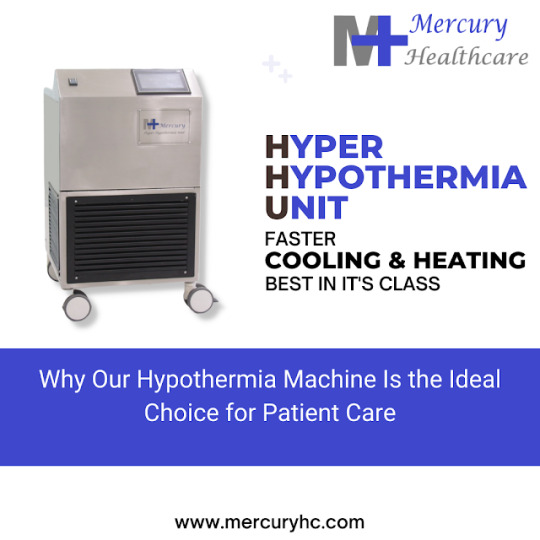
When it comes to providing effective therapeutic hypothermia treatment, choosing the right Hypothermia Machine is paramount. With several options available on the market, it is crucial to select a device that prioritizes patient safety, ease of use, and optimal outcomes. In this blog post, we will discuss the key reasons why our hypothermia machine stands out as the ideal choice for healthcare providers, ensuring the highest standard of care for patients in need of cooling therapy.
Precision Temperature Control:
Our hypothermia machine boasts state-of-the-art temperature control technology, enabling precise and accurate regulation of body temperature. Maintaining a stable hypothermic state is essential for effective treatment, and our machine ensures that the target temperature is consistently achieved and maintained throughout the cooling period. This level of precision minimizes temperature fluctuations, optimizing patient outcomes and reducing the risk of complications.
User-Friendly Interface and Intuitive Design:
We understand the importance of user-friendly equipment in a healthcare setting. Our hypothermia machine features an intuitive interface and ergonomic design, making it easy for medical professionals to operate. Clear and concise controls, coupled with a user-friendly touchscreen, streamline the cooling process, allowing healthcare providers to focus on delivering quality patient care. Additionally, the machine’s compact size and maneuverability enhance its versatility and ease of use in various clinical settings.
Advanced Safety Features:
Patient safety is our utmost priority, and our hypothermia machine incorporates advanced safety features to ensure a secure and controlled cooling environment. The machine is equipped with sophisticated temperature sensors and alarms that promptly notify healthcare providers of any deviations from the desired temperature range. This proactive monitoring system helps prevent potential complications and enables immediate intervention, guaranteeing patient safety throughout the cooling therapy.
Customizable Treatment Options:
Every patient is unique, and their treatment requirements may vary. Our hypothermia machine offers a range of customizable treatment options, allowing healthcare providers to tailor the cooling therapy to individual patient needs. Adjustable temperature settings, duration of therapy, and other parameters can be easily modified, ensuring personalized care and maximizing the effectiveness of the treatment for each patient.
Seamless Integration and Data Management:
Integrating our hypothermia machine with existing hospital systems is hassle-free, thanks to its compatibility with electronic medical records (EMR) and data management software. The machine seamlessly integrates with hospital networks, enabling real-time data monitoring, automatic charting, and comprehensive documentation of patient progress. This integration streamlines workflow, enhances communication between healthcare providers, and facilitates accurate and efficient data analysis for improved clinical decision-making.
Conclusion:
Selecting the right hypothermia machine is crucial for delivering optimal patient care during therapeutic cooling treatment. Our hypothermia machine combines precision temperature control, user-friendly design, advanced safety features, customizable treatment options, and seamless integration with hospital systems. By choosing our machine, healthcare providers can ensure the highest standard of care, maximize treatment efficacy, and improve patient outcomes. Invest in our Medical Equipment Manufacturer hypothermia machine and experience the difference it can make in delivering exceptional cooling therapy for your patients.
#Cardiac Surgery Machine#Heater Cooler Machine#Hyper-Hypothermia Machine Supplier#Hypothermia Machine#medical equipment manufacturer#Hyper-Hypothermia Machine#Fast Cooling machine#Hyper-Hypothermia Machine Supplier in india#hypo hyperthermia machine#hypothermia equipment
0 notes
Text
Maquet Jostra HL 20 Heart-Lung Machine – The Best Choice for Cardiac Surgery

When it comes to advanced cardiac surgery, having a reliable heart-lung machine is crucial. The Maquet Jostra HL 20 Heart-Lung Machine stands out as one of the most efficient and trusted devices for extracorporeal circulation. As a leading supplier and trader of heart-lung machines in India, Octopus Medical Pvt Ltd provides high-quality surgical equipment to hospitals and healthcare facilities.
Why Choose the Maquet Jostra HL 20 Heart-Lung Machine?
The Maquet Jostra HL 20 is designed to ensure precise control over extracorporeal circulation during open-heart surgery. This system offers superior safety, efficiency, and ease of use, making it a preferred choice for healthcare professionals.
Key Features of Maquet Jostra HL 20
Four-Pump System – The machine comes with a complete four-pump system, ensuring smooth blood circulation during surgery.
Pressure and Temperature Monitoring – It includes an advanced pressure and temperature monitoring system to maintain optimal conditions for patients.
Air Emboli Protection – This machine features an air emboli protection system that helps reduce the risk of air bubbles entering the bloodstream.
Cardioplegia Monitor Unit – The integrated cardioplegia monitor unit helps control the delivery of cardioplegic solutions for myocardial protection.
Technical Specifications
Console
Automatic function test
Periodic sampling
Emergency power backup
Power supply: 230V/50Hz
Power consumption: 230V/1450W
Roller Pumps
RPM range: 0-250 R/min (clockwise/anticlockwise)
Flow rate: 0-10 L/min
Occlusion: 0.03 mm
Pressure Regulation
± 997 mmHg
Activation: 1 mmHg
Optical & acoustic alarm release
Digital readout
Temperature Measurement
4 channels with sensors
Measurement range: 0 – 50°C
Optical & acoustic alarm release
Digital readout
Bubble Detector
Detects bubbles larger than 300 micrometers
Automatic pump stop at >0.065 qcm
Level Detector
Stop limitation: 10 mm
Octopus Medical Pvt Ltd – Your Trusted Supplier
Octopus Medical Pvt Ltd is a trusted trader and supplier of heart-lung machines in India. We offer high-quality Maquet Jostra HL 20 Heart-Lung Machines to hospitals, cardiac centers, and medical professionals.
Why Buy from Octopus Medical Pvt Ltd?
✅ Genuine products from top brands ✅ Competitive pricing ✅ Reliable after-sales support ✅ Fast and secure delivery
Conclusion
The Maquet Jostra HL 20 Heart-Lung Machine is a top choice for cardiac surgery due to its cutting-edge features and advanced safety systems. If you are looking for a trusted supplier in India, Octopus Medical Pvt Ltd is your best option.
For more details, visit Octopus Medical Pvt Ltd today!
#Maquet Jostra HL 20 Heart-Lung Machine#Heart-lung machine supplier in India#Best heart-lung machine for cardiac surgery#Surgical heart-lung machine price in India#Buy heart-lung machine online#Cardiopulmonary bypass machine supplier
0 notes
Text
Sorin Stockert 3T Heater-Cooling System manufacturer & supplier in India: Octopus Med Pvt Ltd.
In the realm of medical technology, innovations play a pivotal role in enhancing patient care and outcomes. Among the many advancements, the Sorin Stockert 3T Heater-Cooler System stands out as a crucial component in cardiac surgeries, ensuring optimal temperature management during procedures. As a trusted manufacturer and supplier of Sorin Stockert 3T Heater-Cooler System in India, Octopus Med brings you the Sorin Stockert 3T Heater-Cooler System, delivering unparalleled performance and reliability.
About the Sorin Stockert 3T Heater-Cooler System
The Sorin Stockert 3T Heater-Cooler System is a sophisticated medical device designed to regulate the temperature of patient's blood and organs during cardiac surgeries. It consists of advanced heating and cooling components that maintain precise temperatures, critical for the success of complex procedures. Octopus Med offers the Sorin 3T Heater Cooler Systems, recognized for their superior quality and performance in the medical community.
Key Features of Sorin Stockert 3T Heater-Cooler System:
Precision Temperature Control: The Sorin Stockert 3T Heater-Cooler System ensures precise temperature management, allowing surgeons to maintain optimal conditions throughout the surgical procedure.
Reliable Performance: With its robust design and advanced technology, the Sorin 3T Heater Cooler guarantees reliable performance, contributing to seamless surgical experiences and positive patient outcomes.
Enhanced Safety Features: Sorin Stockert 3T Heater-Cooler Systems are equipped with enhanced safety features to mitigate risks and ensure patient safety during cardiac surgeries.
User-Friendly Interface: The intuitive interface of the Sorin Stockert 3T Heater-Cooler System facilitates ease of use for healthcare professionals, enabling efficient operation and monitoring during procedures.
Buy SORIN Stockert 3T at Best Price in India
Octopus Med offers the Sorin Stockert 3T Heater-Cooler System at the best price in India, making advanced medical technology accessible to healthcare facilities nationwide. Our commitment to affordability and quality ensures that healthcare providers can procure essential equipment without compromising on performance or budget.
Why Choose Octopus Med for Sorin Stockert 3T Heater-Cooler System?
Quality Assurance: Octopus Med is dedicated to delivering products of the highest quality, backed by rigorous quality assurance processes and adherence to international standards.
Expertise and Experience: With years of experience in the healthcare industry, Octopus Med has established itself as a trusted name, offering innovative solutions and unparalleled customer service.
Customer Satisfaction: At Octopus Med, customer satisfaction is paramount. We strive to exceed expectations by providing timely support, seamless transactions, and personalized service to our clients.
Nationwide Reach: Octopus Med's extensive distribution network ensures prompt delivery of Sorin Stockert 3T Heater-Cooler Systems to healthcare facilities across India, enabling timely access to essential medical equipment.
In conclusion, the Sorin Stockert 3T Heater-Cooler System from Octopus Med India represents a paradigm shift in cardiac surgery technology, empowering healthcare providers to deliver superior patient care. With its advanced features, reliability, and affordability, the Sorin Stockert 3T Heater-Cooler System is a valuable addition to any cardiac surgery suite. Contact Octopus Med today to buy SORIN Stockert 3T at the best price in India and elevate your surgical capabilities to new heights.
#heater cooler systems for patients#Buy Heater Cooler For Heart Lung Machine In India#Buy SORIN Stockert 3T at Best Price in India#Sorin 3t Heater Cooler#Sorin Stockert 3T Heater-Cooler#Sorin 3T Heater Cooler Systems#Stockert 3T Heater-Cooling System#About the Sorin Stockert 3T Heater-Cooler System#Sorin Stockert 3T | Heater/Cooler Systems#What is a Heater-Cooler Device?#Patient Cooling and Warming Systems#heater-cooler unit cardiac surgery#Patient Warming#Cooling in One System#Heater-cooler units used during cardiac surgery#Heater Cooler Device For Heart Lung Machine#Warming & Cooling Devices in Healthcare#Patient Cooling System#Patient cooling system - All medical device manufacturers#Heater Cooler Systems Supplier#Heater-Cooler Devices#heater-cooler device#sorin 3t heater-cooler service manual#heater-cooler perfusion#terumo heater cooler
0 notes
Text
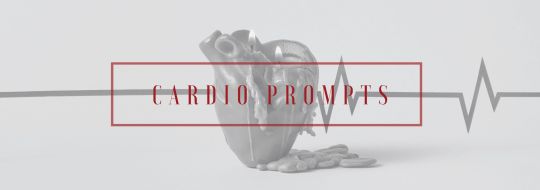
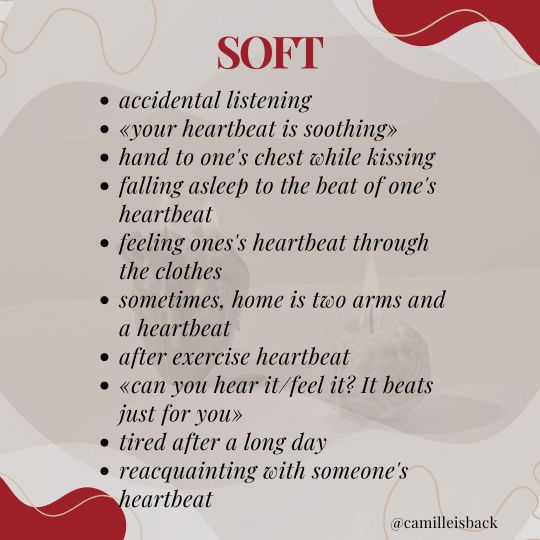
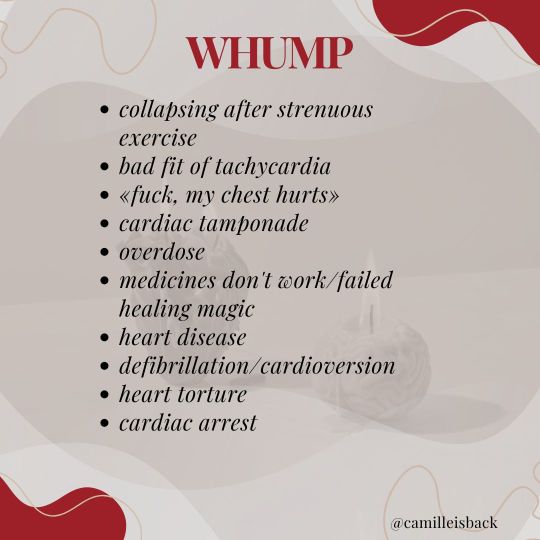
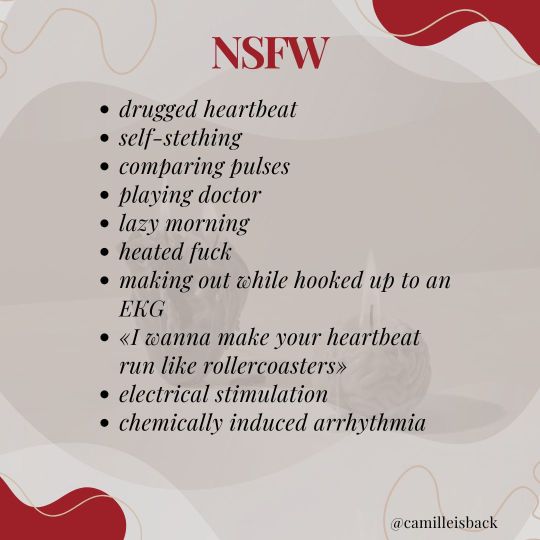
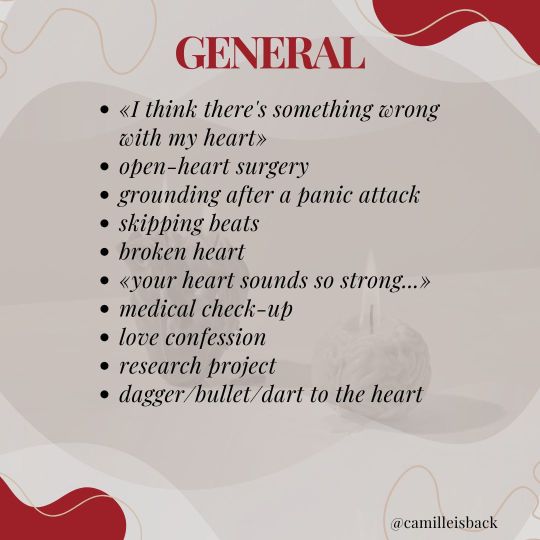
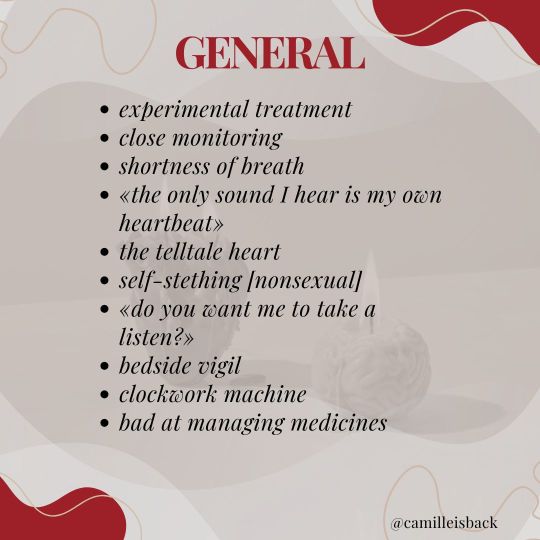
Since some of us have noticed a lack of cardiophilia centered/heartbeat related prompts on this site, I've come up with a short, non-exhaustive list to boost your writing!
Text version under the cut:
CARDIOPHILIA/HEARTBEAT RELATED PROMPTS
SOFT:
accidental listening
"your heartbeat is soothing"
hand to one's chest while kissing
falling asleep to the beat of one's heartbeat
feeling one's heartbeat through the clothes
sometimes, home is two arms and a heartbeat
after exercise heartbeat
"can you hear it/feel it? It beats just for you"
tired after a long day
reacquainting with someone's heartbeat
WHUMP:
collapsing after strenuous exercise
bad fit of tachycardia
"fuck, my chest hurts"
cardiac tamponade
overdose
medicines don't work/failed healing magic
heart disease
defibrillation/cardioversion
heart torture
cardiac arrest
NSFW:
drugged heartbeat
self-stething
comparing pulses
playing doctor
lazy morning
heated fuck
making out while hooked up to an EKG
"I wanna make your heartbeat run like rollercoasters"
electrical stimulation
chemically induced arrhythmia
GENERAL:
"I think there's something wrong with my heart"
open-heart surgery
grounding after a panic attack
skipping beats
broken heart
"your heart sounds so strong..."
medical check-up
love confession
research project
dagger/bullet/dart to the heart
experimental treatment
close monitoring
shortness of breath
"the only sound I hear is my own heartbeat"
the telltale heart
self-stething [nonsexual]
"do you want me to take a listen?"
bedside vigil
clockwork machine
bad at managing medicines
#cardiophilia#cardiophile#heartbeat#cardiophilia writing#prompts#writing prompts#fanfiction#inspo#writing inspiration#writerblr#writing community#whump#hurt/comfort#whump community#medical writing#medical whump#heartbeat kink#medical kink
205 notes
·
View notes
Text
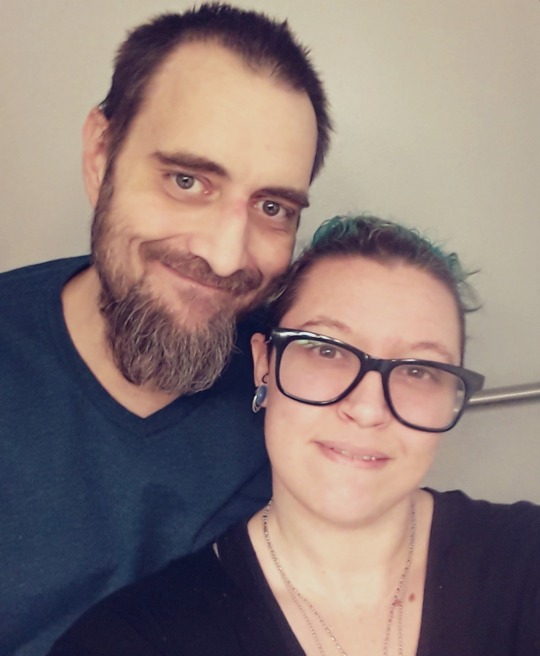

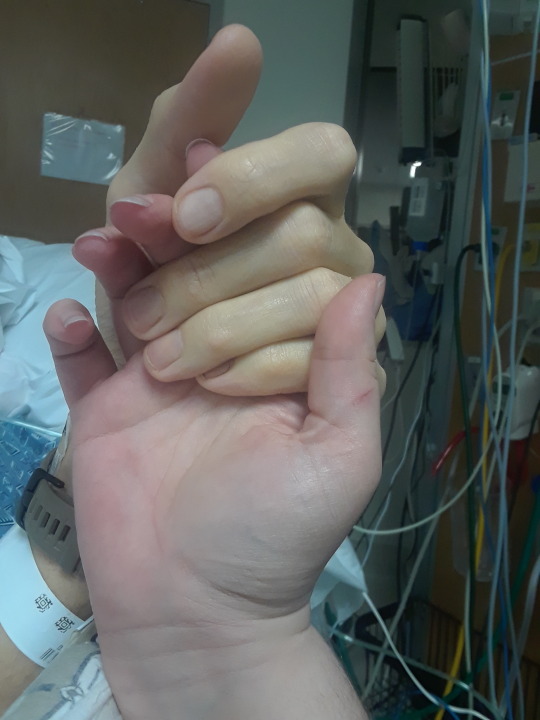
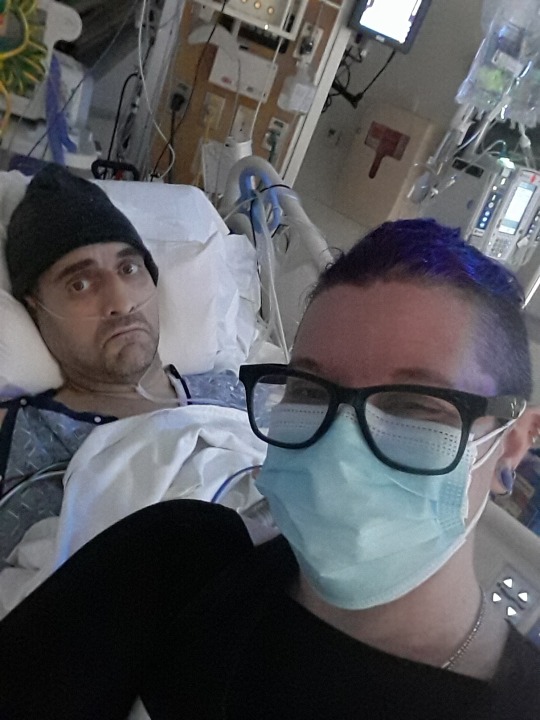
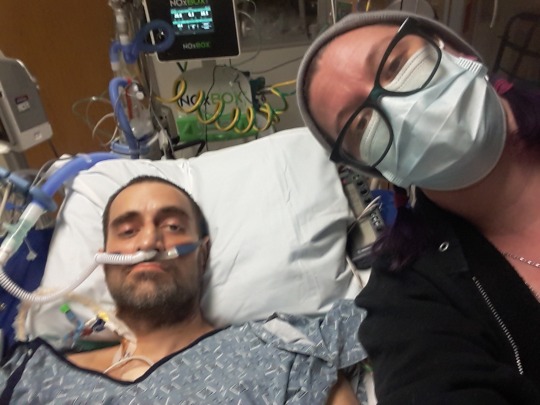
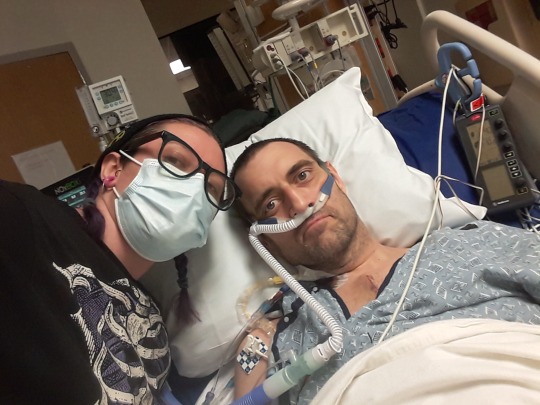
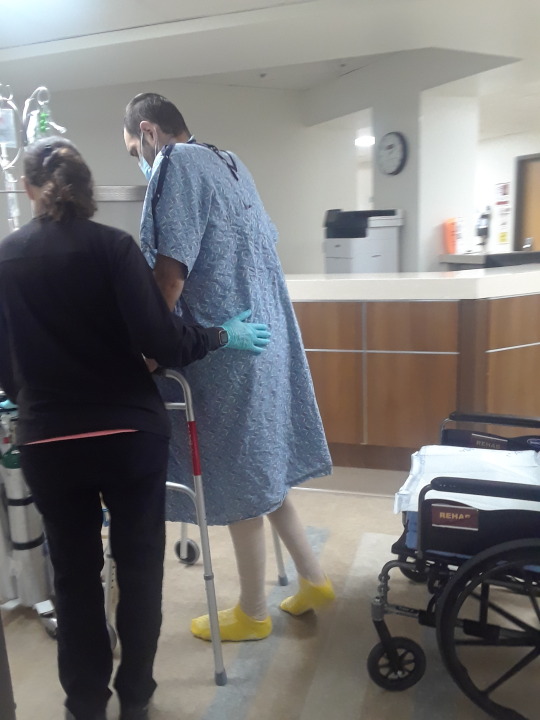
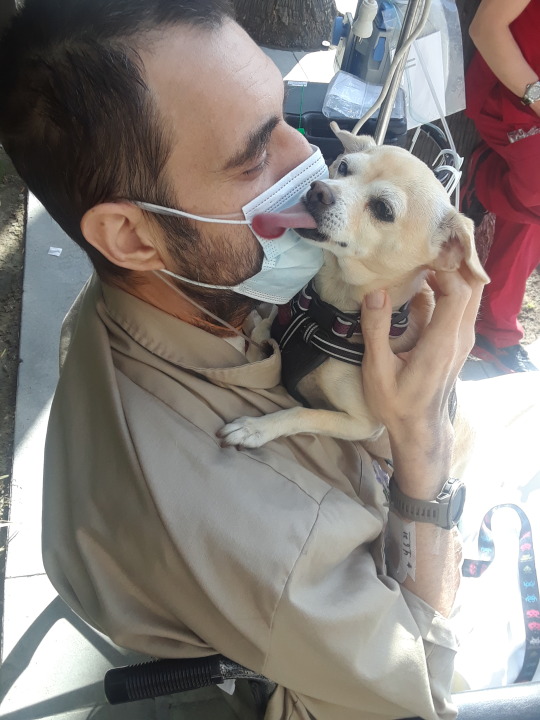

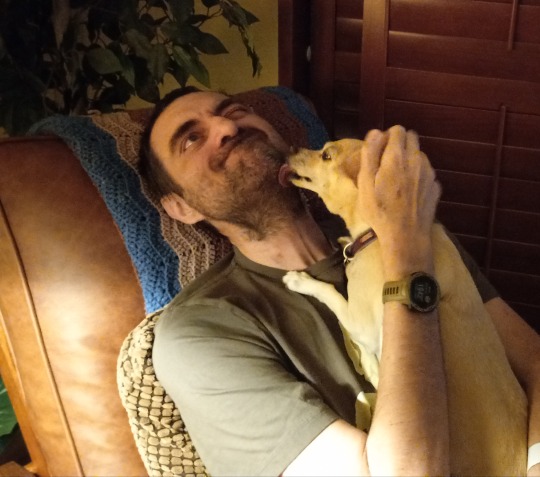
IDK that I've ever put it in one post before, but here's the transplant speedrun.
1 - Valentines day 2021, he's admitted to the hospital. We take a pre-hospital selfie then I shave his head and he shaves his beard because he doesn't want to deal with hair at the hospital. Me and his mom drop him off; at that point you can only visit someone as they are actually dying and we're told that he's going to stay in the hospital until he gets a transplant or he dies, and if he's rejected as a transplant recipient he'll receive palliative care in this hospital.
2 - First week of March, they allow patients to have one screened visitor; this is our first visit - I take photos in the hospital to show his mom because at this point he has a pump in his shoulder and it is difficult for him to move his arms to use his phone. He has also been confined to a bed since the week he arrived because he's on the ECMO machine, so he can't walk or move around, though they stand him up every once in a while. At one point one of the ecmo tubes pulls out of his femoral artery, which is Not! Great! He also needed a blood transfusion about every two days at that point, which worried the doctors because it increased his likelihood of rejecting. But he had been approved for transplant at that point!
The first thing he said to me on this visit was "look, I have abs" and then he showed me his abs because it turns out when you're really really dying of heart failure your body begins to eat itself.
3 - Now That's What I Call Jaundice (cardiac cirrhosis is liver failure as a result of heart failure and it's pretty much the big giant neon flashing sign of heart failure that says "hey you're fucking dying" so if you've got heart failure and your bilirubin number is off or the whites of your eyes are yellow please kick up a gigantic stink until they check your liver; large bastard's GP, who is my doctor, who I hate, saw his bloodwork with a very high bilirubin number a month before he was diagnosed with cardiac cirrhosis and wrote it off as a testing fluke fuck that guy)
4 - Don't let the sad face fool you, he's acting pathetic so that his mom will stop yelling about the fact that I'm bringing him cookies. He's allowed to have cookies. At that point he weighed 98kg and was outsourcing his heartbeat, he was allowed to eat whatever he wanted. (have i mentioned that I was moving us from Vegas to LA at this time? I was bringing him cookies because I'd baked hundreds of peanut butter cookies and other cookies to use up the flour, sugar, and peanut butter in the vegas house)
5 - Mid-march, he's got a match! He called me when I was in Vegas filling up the truck with another load and I drove right back and to the hospital. Once he went in for surgery I drove to his mom's house and crashed, then woke up and drove to our storage unit and unpacked the truck while I waited to hear from the doctors. I was unloading a bookcase when I got the call. (There wasn't any point in waiting alone in the hospital for sixteen hours; either he was going to make it or he wasn't and someone was going to have to unload the truck at some point. People have been weird about this, like I should have been sitting at his side all the time, but there was a two-hour daily limit for most visits and look i have sat in a waiting room while this dude had a thirteen hour surgery i do not need a repeat of that experience without the soothing balm of nicotine getting me through it; so unloading a truck it was)
6 - Two days after surgery and kind of mad about it. His chest hurt a lot (obviously) but, like, a lot a lot because they'd had to open him up for the bypass just two years earlier.
7 - First walk outside of his room after transplant in early April; he needed a LOT of PT because of how much muscle he'd lost. He lost sixty pounds in the hospital before the surgery, and only gained back about twenty while he was in there.
8 - A visit from the tiny doggo
9 - I come to visit and I've got a new phone with a portrait mode so he steals it and takes stupid pictures for a few minutes. Dude is bored and restless; this is in late april and he's feeling well enough to be moody. ETA: There is a jar of pickles in front of him because he'd been fluid limited for a long time and his salt levels were off and when he got to the hospital they were like "you need electrolytes and a lot of salt" and he was like "sweetheart can you please please please bring me delicious salty things" so I was bringing him jars of pickled mushrooms and garlic stuffed olives and just a huge number of pickles that he kept trying to share with the nurses. "Alli brought the mushrooms again; would you like a pickled mushroom? I have fancy toothpicks to share them with!"
10 - He comes home for the first time in early May; he ends up getting readmitted two more times because of complications before finally being released in early July. ETA: The second time he got readmitted it was for something that he wasn't at all worried about but that they needed to monitor for a couple weeks so he was *SO BORED* and actually feeling pretty okay; so at one point when I was leaving the parking garage at 8pm my car wouldn't start, I did some troubleshooting with the manual and the internet and didn't figure it out, so I called him and he tried to troubleshoot over the phone and got frustrated and was begging his nurses to let him come out to the parking structure to work on my car (they refused) - I ended up getting a tow and fixing it when I replaced the battery terminals.
Photos are all posted with his permission.
Also I dyed my hair purple between photos one and two because it's his favorite color. I also bought a blue dress, red tights, and yellow shoes to wear to visit him because he always teases me for wearing so much black.
I just love him a lot. It was a hard couple years there, but things are getting better.
431 notes
·
View notes
Text
WIP Hospital: Surgery

*Meredith Grey monologue voice* Writers really batter their characters and sometimes the damage is so great that they have to be seen to by the professionals and if you've really messed them up, they may need surgery.
Before Surgery

Before any surgery, the patient must be prepared for the procedure. They will be prepped by nurses and doctors but there are things every patient must go through before the surgery especially if they undergo general anesthesia.
No drink/food for a set period of time before the surgery.
Removal of necessary hair
Possible enema but not always necessary
Thoroughly bathed and cleansed, the patient should not use any makeup, nail varnish or perfume
Tests maybe run prior to surgery such as blood tests
All piercings, protesthetics
The preparation of advance directives such as DNRs and wills etc
What is in an OR?

OR or operating room is where operations take place - or would be if your character was having surgery at hospital (they aren't, are they?)
Surgical Lights: Surgeons have to see why they are doing so high powered lighting is used to illuminate the patient and cavity.
Operating Tables: Operating tables are where the patient lies while the surgeons are trying to save their life. also known as surgical tables, are essential to any operating room.
Surgical Displays: These are screens that magnify the cavity for the OR, sort of like tvs that allow everyone a view of what's going on.
Blanket Warmers: Or warming cabinets. These are where the IV fluids, linens, and blankets are kept.
Scrub Sinks: This is where the surgeons abd nurses and technicians get washed up, sterilised and gowned.
Vital Signs Monitor: This is a machine that tracks the patient's heart rate, oxygen saturation, breathing rate and blood pressure.
Ventilator: A ventilator helps the patient breathe while on anesthesia.
Anesthesia Machine: This machine delivers anesthesia to the patient and monitors the level.
Diathermy or Electrocautery Machine: This is used to cut tissue and control bleeding
The Surgical Team

These are the people present in the OR besides the patient. It is up to them to keep the patient alive of course but to also ensure that safety and cleanliness are upheld.
Surgeon: Is the lead of the team and responsible for the planning and cutting of the patient. Most surgeons are specialists.
Surgical Assistant: They work alongside the surgeon, helping the surgeon.
Scrub Nurse: Scrub nurses are in charge of making sure everything stays sterile. They sterilise the surgical instruments and are in charge of minimalising contamination.
Anesthesiologist: The doctor who specialises in anesthesia who monitors the use of anaesthesia.
Circulating Nurse: Circulating nurses manage supplies, equipment and may run messages if needed outside the OR.
Observer: Sometimes med students or other surgeons will observe the surgery. They aren't essential.
General Surgerical Tools

These are just a few tools used with surgeries.
Scalpel – These are the blades used to cut into tissue.
#10: Scalpel with a large curved edge used for making large incisions.
#11: Scalpel with a triangular blade used to make short, shallow cuts.
#12: A small, crescent-shaped blade used to cut sutures
#15: used for short, precise cuts because of its small blade. Ideal for making short, precise incisions because of its small, curved cutting edge. Mostly used in cardiac surgery.
#17: Flat, chisel-like blade for narrow cuts
#18: Narrow, chisel blade for deep cuts and scraping
#20: Large curved blade, used when making a puncture or cut.
#21: Large curved blade, for slicing tissue and puncturing. commonly used for cutting tissue and other procedures that require a puncture or cut.
#22: Like the #10, it is flat and curved cutting edge, used on thick skin.
#23: Large blade that is slightly narrower but pointier
#24: Wide, flat blade with an angle used to make cuts at the corner, used to trim and strip
Forceps - are a gripping tool. Not to be confused with hemostats.
Allis Forceps: Have little teeth running along in them and are for firm tissue such as fascia.
Babcock Forceps: Smooth ended jawed forceps that are used for delicate tissue.
Dunhill Forceps: Small curved, serrated forceps used to hold vessels before ligation.
Lane Tissue Forceps: Forceps with interlocking teeth used to hold tough tissue
Littlewood Forceps: These forceps have blunt teeth, used for tough tissue as well as gaining entry through the umbilicus in laparoscopic surgery.
Sawtell Forceps: curved serrated forceps with a serrated end used to grip vessels
Spencer Wells: Can be curved or straight. They are used to clamp medium/large vessels before ligation
Debakey Forceps: Smooth forceps used for many things but used to grip tissue
Lanes Forceps: Toothed forceps used to grasp most tissues but not the bowel.
Gillies Forceps: Narrow forceps with teeth used on skin.
Scissors - are used to cut sutures and snip things during surgery.
Mayo Scissors: Heavy scissors with blunt ends, either curved or straight, used to cut thick tissue and sutures.
McIndoe Scissors: Curved scissors used to cut/dissect tissue
Hemostats - these are used to clamp vessels to prevent blood flow into the cavity the the surgeons are working in.
Adson Forceps: Can be straight or curved, with either semi-serrated tips or toothed tips, used to clamp vessels and tissues.
Artery Undermining Forceps: Toothed forceps, with ratchetted ringlets. Can be straight or angled, used to hold thick tissues during cardiothoracic surgeries
Bainbridge Forceps: Forceps with long jaws with serrated tips, used to clamp the bowel.
Crile Forceps: A clamp with horizontal, serrated jaws, that can be curved or straight. These are used in laparoscopical practices, for clamping tissue and vessels for cauterization and ligation.
Dandy Forceps: These forces are curved, with half-serrated jaws. Used to control the flow of blood.
Ferguson Angiotribe Forceps: Interlocking blades, curved or straight, used to clamp vessels to control blood flow.
Gemini Mixter Forceps: Curved and serrated, used to hold damaged and delicate vessels during cardiothoracic surgery.
Hartman Forceps: These are narrow, serrated, straight or curved but used primarily for left-handed surgeons. They are used to clamp small vessels.
Jacobson Forceps: Forceps with serrated curved jaws. Used for closing a wound or in tonsillectomies.
Kelly Forceps: Forceps with half-serrated jaws, either curved and straight. They are used for clamp
Kocher Hemostatic Forceps: Has serrated jaws and toothed tips. Used for grasping large blood vessels to control blood flow and holding dense tissue.
Lovelace Forceps: Forceps with fully serrated jaws, used for clamping vessels in gynecologic procedures.
Mikulicz Forceps: Half-serrated jaws with curved tips. Used for clamping the peritoneal sac during abdominal wall closure and the peritoneal tissues in the pelvic cavity.
Mixter Forceps: Right-angled jaws with longitudinal serrations, straight, curved patterns which can be half and fully-serrated. These are used for hard to reach places, used to hold tissue, blood vessels and stitches.
Mosquito Forceps: Short, serrated jaws used for incisions and thin tissues, usually before cauterization.
Rochester Carmalt Forceps: Long, wide serrated jaws. Used for grasping blood vessels.
Rochester Ochsner Forceps: These are used to objects and blood vessels during orthopedic procedures.
Retractors - used to pull back the flesh so the surgeon has better view
Langenbeck Retractor: Hook-shaped retractor, used to separate the edges of wounds. They can come in different sizes depending how deep you want the wound tract.
Norfolk and Norwich Retractor: This retractor is self-retaining, used to keep deep wounds open.
Travers Retractor: Also a self-retaining retractor, but used for much shallower wounds
Other Tools
Cauterization device: used to cauterizate blood vessels to prevent bleeding.
Needle Holder: Used for holding needles while suturing, it looks like a pair of scissors
Rampley Sponge Holding: used to store sponges and gauze
Towel clips: Used to keep towels and drapes in the place
Suction: This machine is sort of like a hose that sucks up blood and other fluids.
Surgical Stapler: Sort of what it says on the tin, a device that staples wounds together quickly.
Laparotomy Sponge/Lap Pad: Is an absorbent pad used to keep the cavity free of excess blood and fluid or to prevent too much bleeding.
Drapes: This is the cloth used to cover the patient and the operating table.
What to Wear to Surgery?

In surgery, contamination is always a fear so the surgeons and their team must dress accordingly in the OR. Most times the patient is draped or wearing a hospital gown.
Protective Cap: This is a cap that covers the hair. Worn by everyone.
Surgical Masks: Worn over the mouth and nose. Usually worn just by the surgical team.
Protective Eyewear: To shield the eyes from blood and debris. Usually worn just by the surgical team.
Gloves: Worn by the surgical team.
Gowns: These are long gowns worn over the scrubs. Worn by the surgical team.
Protective Shoe Covers: Worn over shoes of the surgical team.
Phrases used in the OR

Operations are high stress situations. Often communication is shortened to quick phrases.
Scalpel: Give me a scalpel
Clamp: Give me a clamp
Suction: Suck up this blood/liquid for me.
Retract: Hold back the tissue
Bovie: Give me the cautery equipment
Sponge count: Count the sponges and towels in case we left one in this here guy
Close: Stitch up the patient
Irrigation: Wash out the wound with water
Intubate: Insert a tube in the patient's throat to help them breath
Extubate: Remove the breathing tube
Airplane: Tilt the bed to expose a lateral portion or change the patient’s hemodynamics.
Donut: A support for the patient’s head after anesthesia.
Jump Room: Another OR prepped and waiting for the surgeon for another surgery
Types of Surgery

Surgeons don't just perform every kind of surgery. Most surgeons stick to a practicular specialty.
General Surgery: General surgery focuses on the abdominal organs.
Cardiothoracic Surgery: Deals with everything in the chest, eg. heart and lungs.
Orthopedic Surgery: Focuses on bones and muscle
Neurosurgery: This surgery focuses on the brain, spinal cord, and nervous system.
Plastic and Reconstructive Surgery: This surgery focuses on cosmetic surgery but also reconstructive procedures.
Pediatric Surgery: For babies, children and teenagers.
Vascular Surgery: Focuses on arteries and veins, everything on the vascular system.
Urology: Focuses on the urinary tract and male reproductive organs.
Otolaryngology (ENT): The ears, nose, and throat.
Gynecologic Surgery: Surgery focusing on the female reproductive system.
Examples of surgery

There are thousands of kinds of surgery but I've just listed a few well known ones here.
Appendectomy: Removal of the appendix
Cholecystectomy: Removal of the gallbladder
Coronary Artery Bypass Grafting (CABG): Bypass surgery performed to improve blood flow to the heart
Cesarean Section (C-section): The removal of a baby from the womb surgically.
Hysterectomy: Removal of the uterus.
Mastectomy: Removal of one or both breasts
Tonsillectomy: Removal of the tonsils.
Biopsy: Removal of tissue for examination.
Carotid Endarterectomy: Removal of blockages from in the arteries.
Debridement: Surgical removal of skin that is damaged or infected.
Dilation and Curettage (D&C): Removal of tissue from within the uterus.
Skin Graft: The planting of healthy skin over areas of damaged skin
Spinal Fusion: Joining two or more vertebrae
Rhinoplasty: Surgery to reconstruct or reshape the nose
Prostatectomy: Removal of the prostate gland
Hernia Repair: The repair of a hernia
Total Knee Replacement: The replacement of the knee with artificial components
Hip Replacement: Replacement of hip with artificial components.
Heart Valve Replacement and Repair: The repair of valves in the heart.
Aortic Aneurysm Repair: Repair of enlarged aorta to prevent rupture.
Pacemaker Installation: The installation of a pacemaker to regulate heartbeat.
Craniotomy: Opening up the skull to treat the brain for tumors, aneurysms or repairing damage.
Spinal Decompression: The relieving of pressure on the spinal cord.
Deep Brain Stimulation (DBS): This is the treatment of the brain with electrical pulses.
Breast Augmentation and Reconstruction: The implantion of artificial breasts for cosmetic reasons or to replace them after trauma or removal.
Liposuction: The removal of excess fat in the body.
Ovarian Cystectomy: Removal of ovarian cysts.
Endometriosis Surgery: Removal of endometrial tissue outside the uterus.
Nephrectomy: Removal of kidney
Ureteroscopy: Removal of obstruction in urinary tract
Vasectomy: The clipping of the male reproductive tracts to prevent fertility.
Colectomy: Partial or total removal of the colon.
Gastrectomy: Partial or total removal of the stomach.
Esophagectomy: Partial or total removal of the esophagus
Septoplasty: The correction of a deviated or damage septum.
Cochlear Implantation: Surgery to grant the hard of hearing or deaf to hear without hearing aids due to an implanted device.
The Winchester Method
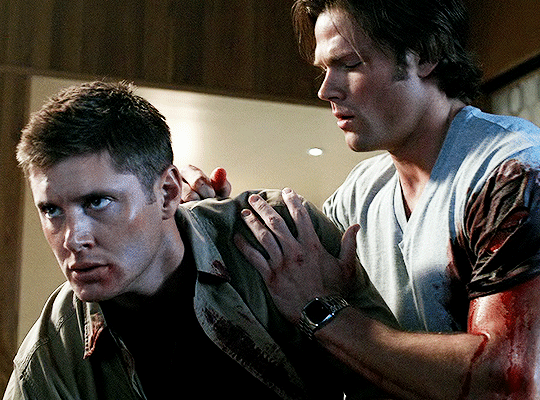
Let's be honest your character is likely not going to hospital for their needed surgery. That bullet is going to be removed elsewhere and that appendix is coming out on the run. We're writers, we sort of use medicine like a fucking jump rope. THIS IS FOR FICTIONAL PURPOSES ONLY. The basic needs of make your own surgerical tools:
Sterilisation: You need something to sterilise your "tools". You can use alcoholic spirits or boiling water or open fire.
Needle and thread: You have to close yourself up, both need to be sterilised. See my post on stitches.
Cauterization: You need may need something to cauterise the wounds or stop bleeding. Something hot, sterile and metal like the flat of a knife can work short term.
Scalpel: You will need a sharp knife, sterilised and appropriately sized like a small paring knife or the blade of a Swiss army knife.
Bandages and towels: Something to soak up blood and cover. Torn up clothes or sheets can be used but most be sterilised.
Anesthesia/Pain Management: Something for the pain. Strong drink can be used to dull the pain but so can over the counter meds.
#I might have been watching a lot of medical dramas recently#I haven't done a wip hospital post in a while#Wip hospital#Wip hospital Surgery#writing#writeblr#writing resources#writing reference#writing advice#writer#spilled words#writer's problems#writer's life#Writing help#Writing research#writeblr community#wtwcommunity#Wtw#Medical au#Hospital au
85 notes
·
View notes
Text
Embrace The Cold - Zayne
Off we go with the second installment of "What could the first time cuddling 'Enter LI name' be like!" This time it is the snowman himself, Dr. Zayne! Honestly this story kinda ran away from me for a bit and got both far more detailed and far far longer than I had planned, so let me know if this is something you like or if you'd prefer it to be kept a lil shorter for the next few! Have fun reading! ---------------------------------------
Over the years Zayne had gotten used to being called cold or uncaring. After a while he had even gotten used to the cold puns because of his demeanor and Evol. By now he didn't even mind those comments anymore. Strangers or even colleagues could call him a man with the emotional warmth of a block of ice all they wanted because he knew that the only person who mattered knew him better.
While he had never gotten any complaints about his bedside manner, at least not since he became head of cardiac surgery, his friends were far and few inbetween when it came to his private life. He cared for his patients with passion and professionalism, offering comfort to the best of his ability but he was also not shy about admonishing them if they disregarded his orders for a speedy recovery.
Yet when he thought back at the few awkward times his well meaning colleagues tried to set him up with friends, he couldn't help but cringe. They had all been lovely people, but Zayne had quickly learned that blind dates were not something he was very proficient in. The small talk about the weather and the place they had met at soon faded into silence and the date usually turned very uncomfortable for both parties involved as well as the waiter.
Zayne sometimes wondered what the waiter thought about him, considering that he met at this restaurant with every date he had been set up with, always being tended to by him. Did he think of him as a socially inept idiot that couldn't charm his way into a second date or just as a playboy who moved on to the next person after he had gotten what he wanted?
But then his mind would shift to you. You were the wrench thrown into the well oiled machine that was his life. After all these attempts at kickstarting his love life, Yvonne had asked him for one more attempt and he had only reluctantly agreed. Unlike the others he had been made to meet with, he immediately felt far more comfortable the second you entered the restaurant, a little late and flustered because of it.
Once you got all the apologies out of your system for being late, none of it actually being your fault, the two of you eased into a very comfortable conversation. There had been no awkward silence between you at any point, you seemed genuinely interested in the things he had to say, asking questions and even prompting him to remind you of your food you were neglecting for the sake of not missing a word. He of course returned your interest, questioning you on your life, your hobbies, whatever came to mind.
Before either of you realized, two hours had passed, you had eaten your dinner and dessert and even your drinks had been emptied for a while.
One date turned into two, then three and before you knew it you were a couple without ever really saying it out loud. In the following days and weeks your relationship developed quickly and also not at all. Due to his busy work life clashing with yours, meetings in person often were few and far inbetween, but you managed to make it up with voice and video calls during the times you had time but were apart.
But now something incredible, almost unbelievable happened. Not only did you manage to secure two weeks of vacation, but Zayne did as well. You had never seen him so giddy with excitement as you picked up his video call in the evening, excitedly telling you about his accomplishment. Plans were quickly made how you two wanted to spend your free time, both together and apart, and before you knew it, the days until your vacation had passed and your doorbell rang.
Zayne was wearing his usual dark attire, his silver glasses perched on his nose and a warm smile on his lips. "Are you ready to leave?" With a kiss to your temple he stepped past you into your apartment, grabbing the suitcase in the hallway as you put on your shoes and jacket. "I can't put into words how excited I am, I haven't had a vacation in forever!" He breathed out a quiet chuckle and waited outside the door as you quickly scanned your apartment again, making sure that you had not left on any lights or appliances before following after him, locking the door behind you.
Zayne was a meticulous driver, never speeding and with his hands always at their correct place on the wheel. Except for today. He was still driving like a model citizen, but unlike usual, your entwined hands were resting on the center console, his thumb rubbing comforting circles on the back of your hand. You had confided in him before that you were a little nervous, this was not only your first vacation together, but also the first night you would spend at his home.
If he was anyone but him, your heart would most likely be beating out of your chest or you would be nauseous from nervousness but this was Zayne after all. Your Zayne. Your gentle snowman of a boyfriend who would spend hours focused on the most complicated surgeries, saving lives with the very hand that now held yours, only to ask you to accompany him to an arcade in the evening so you could help him win a plushie to give to a young patient of his.
You have sat in at a lecture he was giving, his professional behaviour and calm voice captivating the audience and another day you saw him walking to the pediatric ward in light blue scrubs covered head to toe with little snowmen so the children wouldn't be as scared.
The car came to a gentle stop at the end of a short traffic jam. Zayne squeezed your hand and his eyes found yours as you turned your head. "What's going on in that head of yours? I can hear you overthinking from here." His smile was as gentle as usual, with an inquisitive look in his eyes.
"I don't know, to be honest. I know I have no reason to, but I think I'm a little nervous." The corner of his mouth twitched upwards a little and he turned his eyes back towards the road, now that the traffic jam had let up a little.
The busy streets of Linkons inner city gave way to a calmer neighborhood and after passing by the security guard of the gated community where Zayne lived, he soon turned into his driveway, only letting go of your hand to park the car and release his seatbelt.
His warm hands then ran along your arm to your hand, resting a moment against your pulse. "I won't dismiss your feelings by telling you there's no reason to be nervous, but you know me. You have gotten to know me better in the short time we have known each other than some people have who have known me for years. There is nothing I expect of you during our vacation except that you enjoy our time together. We get so little of it as it is."
He lifted your entwined hands and gave you a small kiss on your knuckles before letting go and exiting the car. You didn't even get the chance to open the door yourself, by the time you had gathered your bag at your feet, it was already open, with Zayne waiting patiently for you.
"Could you get the door? I had your fingerprint added to the automatic locking system." Zayne asked from behind you, hands full with your suitcase and his coat. As promised, the door gave a quiet click as you pressed your thumb on the scanner and the clean, almost clinical scent of his home greeted you.
It was almost funny how even his home held so many traces of his work, from the academic books and texts taking up an entire bookcase on their own, to his academic certificates lining the wall. When he had invited you over for the first time it even smelled like a hospital. There was the ever persistent scent of antiseptic, antibacterial soap and what you later learned was a hand lotion specifically formulated for medical personell that had to wash and desinfect their hands very frequently.
He had explained that as a surgeon, fragrances of any kind were not permitted and considering how much time he usually spent in the hospital, those habits had simply carried over into his private life. He didn't mind perfumes, colognes or any kinds of room sprays, he just didn't see a need to purchase them if they would only go to waste anyway. But ever since you had commented on it, not in a mean way in the slightest, he had started to experiment.
The next time you visited there was a faint scent of vanilla in the air, not overpowering but still clashing with the "natural" scent of his home. After that it was the scent of pine trees and eucalyptus which made everything smell like a very strange medicinal spa treatment. That one was discarded as well.
In the end, with your help, he had settled for a very unoffending citrus scent. It wasn't too harsh and also didn't clash. Instead of smelling cold and uninviting, his home now just simply smelled clean. He himself was an entirely different story. At his insistence, you two had once gone to try out some perfumes and colognes, with nothing to show for it but a headache and a desperate need for a shower and fresh clothes.
The two of you dropped down on his sofa, both tired from a long day of work and ready for a day of relaxing tomorrow and the two weeks of vacation that would follow. "I had planned to cook something nice together, but I did not anticipate how exhausting work would be today. I hope you are fine with takeout as well?" You could only nod and let your head drop back to rest on the backrest.
You couldn't imagine how extreme an exhausting workday would be for a surgeon, but yours had not been any better. Running from meeting to meeting, talking to customers and colleagues, having to forego your lunch break and just having to sneak some bites as you were once again rushed to yet the next thing you had to worry about. The rest of the week had not been any better, leaving you with no time to actually pack and prepare your apartment for your abscense until you got home in the afternoon today.
There were some minutes of silence as the two of you just lounged on the sofa, with Zayne copying your position with his long legs stretched out as far as they would go and his head tilted back. It wasn't particularily comfortable, but neither of you had the energy to move a muscle now that you had sat down.
His fingers were tapping gently along the cushions until they found yours, immediately wrapping around them. Soon the silence was starting to hurt your ears and you moved with a groan, stretching your arms and legs, allowing your joints to pop as you did. You quickly decided on tonights dinner and after ordering you both took turns in the bathroom to wash up and get changed out of your work clothes into something more comfortable.
During your dinner you shared some stories of your day, with Zayne talking more about the antics of his coworkers to avoid sharing information he was not permitted to and you venting about your lack of a lunch break and how many times you had to repeat yourself with those customers who did not seem to grasp even the simplest concepts.
Stuffed with dinner and dessert to full capacity, you quickly washed the dishes and debated what you would want to do with the rest of the day. It was too late and you both were too tired to go out again but it was still too early to go to bed yet. Tomorrow was already a day planned with mostly laying around and maybe going shopping for some last minute necessities before your vacation, so going to bed early tonight would only make you wake up far too early.
After your first time visiting, you had commented on Zaynes rocking chair, wide enough for one person to more than comfortably sit on, but still too narrow to fit you both. It had merely been a cheeky comment, with no intention behind it, yet when you had entered his apartment this time, the rocking chair had been banned to the bedroom, making for a comfortable reading space right by the windows and in it's place in the living room now stood something you could only call a rocking sofa.
It was a two seater, plush and comfortable with dark grey fabric, with more than enough space to even lay down and stretch your legs. There was also a small sideboard in front of it with a TV and the console you had played on together before.
"Please don't tell me you bought that just because of the comment I made." You said with a deadpan voice, scratching your temple with a sigh. Zayne placed a smooch on just that spot and turned to lead you over to the sofa. "Very well, then I won't tell you. I did not want to break it in on my own and now seems like a perfect opportunity. What do you say?" With a snort you ushered him along with a small smack to his butt, laughing at the way he nearly jumped out of his skin and turned to give you a playful glare.
He held the chair still so you could get on without an issue and watched with a smile as you stretched yourself out as much as you could. "Comfortable?" He asked, pushing and pulling on the back rest to make you rock back and forth ever so gently. "It is…but I bet it would be even more comfortable with company." You didn't have to ask him twice, tapping the space next to you with your fingers, you couldn't help but giggle at the violent rocking that shook you about as he sat down.
Sitting there together, with Zayne resting one of his legs on the ground to keep up the gentle rocking, you quickly felt drowsiness taking over you. "I never understood why parents like rocking chairs so much to put their kids to sleep." Your sentence ended with a big yawn, the kind that made your eyes tear up. Zayne did not comment and as you turned to your side to look at him, you saw that his eyes were closed.
His breathing was slow and calm but by the way he was still rocking the chair, you were certain that he had not already fallen asleep. His breath hitched a little as you raised your hand to trace some of the scars on the arm he had resting on his stomach. "Are you still nervous?" The room had gotten so quiet that his voice made you flinch a little.
He turned his head towards you when you didn't answer right away. Your fingers that had been running over his arms crept up to his jaw, running along the sharp bone, tracing his cheekbones to his temple, before brushing his dark hair away from his hazel eyes. "You told me I don't have to be. And you're right…I do know you, my precious snowman who will protect me just like I will protect you. I know that as long as I'm with you I will be safe."
For a split second you thought you saw a flash of pain run across his face, but with a blink of you eyes, it was gone. He turned over to face you fully. His arms slowly reached out towards you, one pushing into the plush cushions to reach under your body, the other circling around your waist and with a quick pull, there was hardly any space between the two of you anymore.
You could feel his breath on your face and in the way his chest pressed against yours, the hand of the arm beneath you settling on your lower back while the other carressed your upper back. For a moment you felt like your heart would start racing again due to the sudden proximity but as you stared at his beautiful features, those intelligent eyes that sparkled in greens, browns and even some specks of yellow, the long lashes that framed them and his plush lips that had made you weak with both words and kisses before, you noticed that it was just as calm as your breath.
Laying in Zaynes embrace, it felt like nothing could touch you, no one would dare to even think of harming you. Now even the thought of worrying about being with him seemed ridiculous. Had he ever even given you a reason to worry? Even your first meeting had just felt right. There was hardly any awkwardness, no uncomfortable silences. Maybe you had been moving rather quickly in the eyes of others, but neither of you regretted anything.
You did not regret telling each other your life stories right away, skipping the pleasantries and fun fact about each other for a later date. You did not regret wanting to give him a kiss on the cheek after he had dropped you off and accompanied you to your front door to make sure you made it home safe and he did not regret accidentally turning his head at just the last second so your kiss ended on his lips instead.
As you shared this intimate moment, a shiver ran across your body. Due to his Evol, Zaynes body tended to overcompensate the cold, making his body run hotter than most people. In turn, he prefered his living space to be on the cooler side. Luckily he was prepared and pulled the blanket, that he had slung over the backrest, over the both of you. As he adjusted on the sofa, he pulled you even closer, tangling your legs together to erase even the last bit of distance between you two.
Sharing your warmth and with the quiet affection visible between you both, you snuggled your face into his chest, the faint scent of something that was purely Zayne tickling your nose. You were safe, you were loved and with those thoughts in mind, you closed your eyes and drifted off to sleep.
45 notes
·
View notes
Text
Akso Hospital

Location: Downtown Linkon City
Clinic Number: 2122637824
Mottos:
"Akso Hospital, for a brighter future"
"For A Better Future of Life"
"Akso Hospital Cares"
Details:
Okay, this is going to be a long one. Rather than try to cram everything into one huge post, I'll be splitting it up into a series of posts to sufficiently cover everything. I'll list the link menu at the bottom of this main post. But first, let's go over the general details of Akso Hospital!
Linkon's municipal hospital, located downtown. A facility focused on medicine, research, and education. Its divisions, such as the Division of Cardiac Surgery and Division of General Surgery, are widely respected. At the forefront of healthcare, it is a world-renowned medical institute.
Features & Facts:
It has its own Flux Stabilizer
The Akso Remote Monitor is a hospital took used for monitoring the health status of remote patients
It has a rooftop helipad with at least two rescue helicopters
Akso Hospital has at least 11 confirmed floors
Patient visits are half an hour
Akso Hospital has a partnership with the Hunter's Association
Akso Hospital has a "Moments" profile with the name "Akso Hospital Official"; One identified writer for this profile has the username "AksoHospitalAssistant"
The protaganist mentions a waiting area with a TV that plays movies. According to Zayne, there's also popcorn in a vending machine next to the nurse's station.


Events:
Hospital Staff's Lottery: This year, the grand prize was a hot springs trip for two. Zayne won.
Patient's Favorite Doctor: An annual public poll the hospital releases. The protaganist says the votes showed Zayne was very popular this year. The winner will be forced to appear in the hospital's promotional videos (a detail Zayne is not excited about lol)


Health Initiatives:
Zayne says the hospital has many health initiatives. But these are the ones specifically mentioned by name:
The Mindfulness Chamber: a mindfulness initiative
Get Out of Bed: an encouragement initiative
Floorplan:
At Akso Hospital, floors are denoted with a letter (possibly indicating the specific building or wing?) followed by the floor number. Rooms, offices, or defined areas on that floor are two-digit numbers. (For example, Room 2 on the fifth floor of building B would likely be written as "B6/B06, Room B02".)
Here are some Akso Hospital room locations I was able to confirm throughout the game:
Floor A8/A08:
00-03: Diagnosis Rooms
02: Division of Cardiac Surgery
04-06: Doctor's Offices

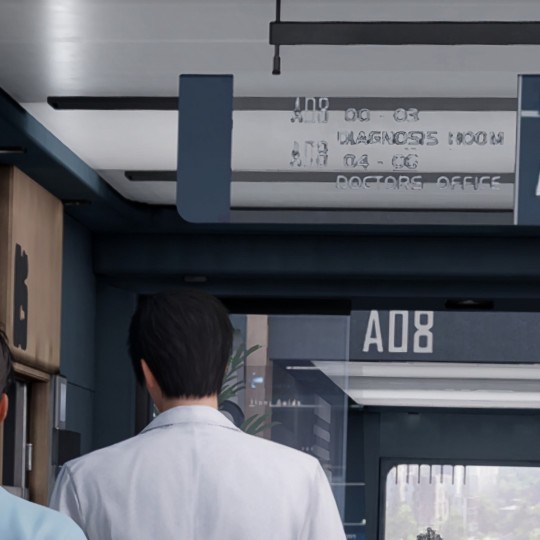
Floor A4/A04:
Reception where Yvonne works
Zayne's check up room is on floor A4
017: Radiotherapy
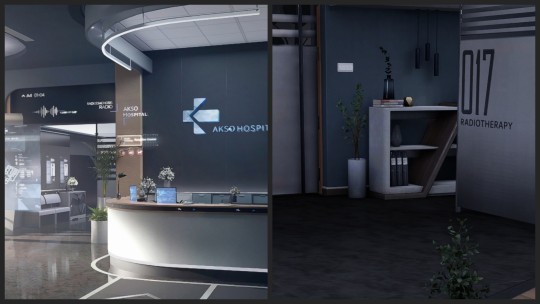
Link Menu:
Archives
Cafeteria
Clinical Research Center
Division of General Surgery
Division of Cardiac Surgery
Division of Evol and Protocore Medical Technology
Emergency Room
Evol-Cardiac Medical Research Lab
Garden
Gynecology
Inpatient Building
Neurology and Sleep Center
Orthopedics
Pediatrics & Pediatric Ward
Public Relations Division
Radiology
Radiotherapy
Rehabilitation Center
Surgery Center
(In-Game Medical Glossary)
25 notes
·
View notes
Text
so, about the people who think that Laziness Is The Worst Sin. you know. those who imagine themselves to be Righteous Bootstrap Pullers.
statistically, a fair number of them will need heart surgery at some point in their lives. do you know how long a human can maintain accuracy at monotonous repetition of a 30-second-long task without a break? neither do I, but it's gotta less than 4 hours.
anyway, they'll need heart surgery. and sometimes it's close to the end of a shift and my brain is mush and I want to cry and I still pull every fiber of will together to keep checking the cardiac cannulae for flaws before I seal them into their pouches.
[correct cuff placement not obscuring airflow. no wrinkles no tears no bubbles no pinholes. sufficient airflow. double check airflow. no leakage from lumen line. printed depth marks and product code legible correct complete aligned. tip formed correctly no sharp edges from bad plastic molding old tipping machine, check with sensitive fingertips; rough edges can perforate. no voids in glue joints no excess glue to chip off and land in a blood vessel. no particulate matter, especially that weird orange stuff that's in the luer caps sometimes.]
people who disdain labor rights will need heart surgery and I will do everything in my power to not let them die on the table. and so I think maybe I should get a couple 15-minute breaks and perhaps the option to wear headphones. so I'm not fatigued. while I'm checking the cannula for your fucking heart surgery.
11 notes
·
View notes
Text
Top 5 Most Needed Equipment in a Hospital
Hospitals are the cornerstone of healthcare, playing a crucial role in saving lives and improving the quality of care. To deliver optimal treatment, hospitals must be equipped with the latest and most essential medical devices. These tools not only enhance diagnostic accuracy but also ensure patient safety and efficient operations. In this article, we’ll explore the top 5 most needed equipment in a hospital, detailing their importance and functionality. If you’re looking to procure high-quality devices, consider exploring options to buy medical supplies online, where convenience meets affordability.
1. Diagnostic Imaging Systems
Diagnostic imaging systems are indispensable in modern medicine, allowing doctors to view and analyze internal structures of the body. Equipment such as X-ray machines, CT scanners, and MRI machines provide critical insights into a patient’s condition.
Why They’re Needed:
Enable early and accurate diagnosis.
Help in planning surgical procedures.
Monitor the effectiveness of ongoing treatments.
Investing in reliable diagnostic imaging systems ensures better patient outcomes and streamlines the treatment process. High-quality imaging devices are widely available through medical supplies online platforms, offering advanced technology at competitive prices.
2. Patient Monitoring Systems
Patient monitoring systems are essential for tracking vital signs such as heart rate, blood pressure, oxygen saturation, and temperature. These systems are particularly crucial in intensive care units (ICUs) and operating rooms.
Key Features:
Continuous monitoring of patient health.
Real-time alerts for any abnormalities.
Integration with hospital information systems for data storage and analysis.
Modern patient monitors are equipped with wireless capabilities, enabling remote monitoring. This feature is invaluable, especially during emergencies or in telemedicine settings.
3. BPL ECG Machine
An electrocardiogram (ECG) machine records the electrical activity of the heart and is essential for diagnosing various cardiac conditions. Among the top-rated ECG machines, the BPL ECG machine stands out for its precision and user-friendly design.
Benefits of BPL ECG Machines:
High accuracy in detecting arrhythmias and heart abnormalities.
Easy-to-use interface for healthcare professionals.
Portability, making it ideal for both hospital and home use.
Cardiac health is a critical aspect of patient care, and a dependable ECG machine ensures timely intervention. Purchasing a BPL ECG machine from trusted sources online guarantees authenticity and quality.
4. Surgical Instruments and Equipment
No hospital can function without a comprehensive range of surgical instruments. From scalpels and forceps to advanced robotic surgical systems, these tools are vital for performing both minor and major surgeries.
Must-Have Surgical Equipment:
Sterilizers to ensure a contamination-free environment.
Laparoscopic tools for minimally invasive procedures.
Advanced anesthesia machines for patient safety during operations.
To maintain high standards of patient care, hospitals must regularly update and replace their surgical instruments. Many healthcare facilities prefer sourcing these items through medical supplies online, ensuring timely delivery and cost-effectiveness.
5. Ventilators and Respiratory Equipment
Ventilators and other respiratory equipment have become indispensable, especially in the wake of the COVID-19 pandemic. These devices provide critical support for patients who struggle to breathe independently.
Importance of Ventilators:
Assist patients with respiratory failure.
Play a crucial role in ICUs and emergency care units.
Provide life-saving support during severe illnesses or post-surgical recovery.
Modern ventilators come with advanced settings to customize airflow and pressure, catering to the unique needs of each patient. Hospitals can explore various models and price ranges by purchasing these devices from medical supplies online platforms.
Why Choose Medical Supplies Online?
The healthcare industry is evolving rapidly, and so is the way hospitals procure equipment. Buying medical supplies online offers several advantages, including:
Wide Range of Options: From basic tools to advanced machinery, online platforms provide a comprehensive selection of medical equipment.
Cost Efficiency: Competitive pricing and frequent discounts make online shopping more affordable.
Convenience: Avoid the hassle of visiting multiple vendors; place orders with just a few clicks.
Authenticity: Reputable platforms ensure that all products meet international quality standards.
2 notes
·
View notes
Text
Sarvamangala Hospital: A Beacon of Healthcare Excellence
Sarvamangala Hospital stands as a symbol of quality healthcare in the heart of its community. With its commitment to providing exceptional medical services, advanced treatment options, and a compassionate environment, Sarvamangala Hospital has earned the trust of countless patients. This article will explore the various aspects of Sarvamangala Hospital, including its history, facilities, medical expertise, patient care, and the impact it has had on the healthcare landscape.
A Brief History of Sarvamangala Hospital
Established several years ago, Sarvamangala Hospital was conceived with a vision to offer high-quality healthcare services at affordable prices to people of all backgrounds. The hospital was founded by a group of dedicated medical professionals who believed in delivering compassionate care to every patient. Over the years, it has expanded its services and improved its infrastructure, becoming one of the most trusted healthcare institutions in the region.
The hospital's name, "Sarvamangala," is derived from the Sanskrit word meaning "all auspicious," symbolizing the hospital's goal of bringing health, well-being, and prosperity to its patients. The founders, deeply rooted in their values, envisioned a healthcare institution that not only treated illnesses but also provided holistic care, ensuring the overall well-being of every individual.
World-Class Infrastructure and Facilities
One of the defining features of Sarvamangala Hospital is its state-of-the-art infrastructure. The hospital is equipped with the latest medical technologies, ensuring that patients receive the best possible treatment. From modern diagnostic equipment to advanced surgical tools, Sarvamangala Hospital invests in the latest innovations to ensure high standards of care.
The hospital has spacious, clean, and well-maintained patient rooms, including private suites, semi-private rooms, and general wards, to cater to the different needs of patients. In addition, the hospital boasts modern operating theaters, ICUs (Intensive Care Units), and advanced imaging facilities such as CT scanners, MRI machines, and ultrasound machines.
The hospital also places a high priority on hygiene and infection control, ensuring that all rooms, equipment, and facilities are sanitized regularly to provide a safe and healthy environment for patients.
Comprehensive Medical Services
Sarvamangala Hospital offers a wide range of medical services, making it a one-stop destination for all healthcare needs. Some of the key departments and services offered at the hospital include:
Emergency Services: Sarvamangala Hospital operates a 24/7 emergency department, equipped to handle a variety of medical emergencies, from accidents to heart attacks and strokes. The emergency team is trained to respond quickly and efficiently to provide immediate care and stabilization.
Surgery: The hospital has a well-equipped surgical department, with highly experienced surgeons specializing in various fields, including general surgery, orthopedic surgery, cardiac surgery, and more. The hospital performs both elective and emergency surgeries, using the latest minimally invasive techniques whenever possible.
Cardiology: With the increasing prevalence of heart disease, Sarvamangala Hospital has invested in a comprehensive cardiology department. The hospital offers diagnostic services such as ECG, stress tests, and echocardiography. It also provides treatment for a variety of heart-related conditions, from hypertension to coronary artery disease and heart failure.
Pediatrics: The pediatric department at Sarvamangala Hospital is dedicated to the health and well-being of children. It provides both preventive and curative care, from newborn care to childhood vaccinations and management of pediatric diseases.
Orthopedics: Sarvamangala Hospital’s orthopedic department provides treatment for bone and joint issues, including fractures, arthritis, spinal disorders, and sports injuries. The hospital employs advanced diagnostic tools and cutting-edge surgical techniques for effective treatment and rehabilitation.
Obstetrics and Gynecology: The obstetrics and gynecology department focuses on women’s health, offering services ranging from prenatal care to postnatal support, fertility treatments, and surgeries for gynecological disorders. The department is known for its expertise in managing high-risk pregnancies and childbirth.
Oncology: Cancer care is another cornerstone of Sarvamangala Hospital. With early diagnosis and comprehensive treatment plans, the hospital offers chemotherapy, radiation therapy, and surgical interventions for various types of cancer. The oncology team works with patients to provide the best possible outcomes.
Nephrology: The hospital’s nephrology department provides comprehensive care for patients with kidney disorders, including dialysis, kidney transplantation, and treatment for chronic kidney diseases.
Gastroenterology: The gastroenterology department provides specialized care for diseases of the digestive system, including liver disorders, IBS, inflammatory bowel disease, and gastrointestinal cancers.
Highly Experienced Medical Team
Sarvamangala Hospital prides itself on having a highly skilled and experienced medical team. The hospital employs top-tier specialists and consultants in various medical fields, all of whom are dedicated to providing the best possible care to their patients. The medical staff is continuously trained in the latest medical advancements and treatment protocols to ensure that patients receive the most up-to-date care.
In addition to its team of specialists, the hospital also employs a well-trained nursing staff, pharmacists, and allied health professionals who work together to provide seamless care throughout the patient's journey. The compassionate attitude of the medical staff is often cited as one of the key reasons patients choose Sarvamangala Hospital.
Patient-Centered Care
At Sarvamangala Hospital, patient care is at the heart of everything. The hospital strives to create a comfortable and supportive environment where patients feel heard and respected. The medical team works closely with patients and their families, providing them with clear information about their conditions, treatment options, and recovery plans.
The hospital offers personalized care plans, ensuring that each patient’s needs are met. Whether it’s managing a chronic condition, recovering from surgery, or undergoing a specialized treatment program, Sarvamangala Hospital emphasizes patient comfort and emotional well-being.
Affordable Healthcare
In addition to its exceptional medical care, Sarvamangala Hospital is committed to offering affordable healthcare. The hospital believes that quality healthcare should be accessible to all, regardless of economic background. The hospital’s pricing is competitive, and various insurance plans are accepted, making it easier for patients to receive the treatment they need without financial strain.
Community Outreach and Social Responsibility
Sarvamangala Hospital also plays an active role in the community, organizing health camps, awareness programs, and free medical check-ups for the underserved population. The hospital’s outreach initiatives aim to educate the public about healthy lifestyles, preventive healthcare, and common diseases, ultimately improving the overall health of the community.
Conclusion
Sarvamangala Hospital has undoubtedly made a significant impact on the healthcare sector by offering world-class medical services, a patient-centered approach, and a commitment to excellence. With its modern infrastructure, skilled medical professionals, and focus on affordable care, the hospital continues to be a trusted name for patients seeking quality healthcare. Whether you need emergency care, routine check-ups, or specialized treatment, Sarvamangala Hospital remains dedicated to improving the health and well-being of its patients, making it a true beacon of healthcare excellence.
2 notes
·
View notes
Text
Medical Equipment Manufacturer and Supplier in India

In the field of healthcare, the quality and reliability of medical equipment play a vital role in delivering effective and efficient patient care. Mercury Healthcare, a leading Medical Equipment Manufacturer and supplier in India, has emerged as a trusted name in the industry. With its commitment to excellence, innovation, and customer satisfaction, Mercury Healthcare has been revolutionizing the healthcare landscape in India. In this blog post, we will explore why Mercury Healthcare is renowned for providing the finest quality medical equipment in the country.
Commitment to Quality: Mercury Healthcare is dedicated to producing medical equipment of the highest quality standards. The company adheres to stringent quality control processes at every stage of manufacturing, ensuring that all products meet international quality benchmarks. By using advanced technology and robust manufacturing practices, Mercury Healthcare ensures that its equipment is reliable, accurate, and durable.
Wide Range of Products: One of the key strengths of Mercury Healthcare is its extensive portfolio of medical equipment. The company offers a comprehensive range of products, including diagnostic equipment, surgical instruments, patient monitoring systems, imaging devices, and much more. Whether it’s a small clinic, a large hospital, or a research facility, Mercury Healthcare caters to the diverse needs of the healthcare industry.
Cutting-Edge Technology: Mercury Healthcare stays at the forefront of technological advancements in the medical field. The company invests in research and development to continuously improve its products and introduce innovative solutions. By integrating the latest technology into their equipment, Mercury Healthcare ensures accurate diagnoses, efficient treatments, and improved patient outcomes.
Customization and Personalization: Understanding that different healthcare facilities have unique requirements, Mercury Healthcare offers customization and personalization options. The company collaborates closely with its clients to understand their specific needs and tailor the equipment accordingly. This approach not only enhances the user experience but also optimizes workflow efficiency in healthcare settings
Compliance with Standards: Mercury Healthcare strictly adheres to national and international regulations and standards for medical equipment manufacturing. The company follows Good Manufacturing Practices (GMP) guidelines and holds certifications such as ISO 13485:2016, ensuring that their products meet the highest quality and safety standards. This commitment to compliance instills confidence in customers, making Mercury Healthcare a trusted partner in the healthcare industry.
After-Sales Support and Service: Apart from manufacturing top-quality medical equipment, Mercury Healthcare places great emphasis on Hyper-Hypothermia Machine after-sales support and service. The company provides comprehensive technical assistance, training programs, and regular maintenance services to ensure the smooth functioning of the equipment. Their prompt and efficient customer service team is always ready to address any queries or concerns.
Conclusion: Mercury Healthcare stands out as a premier medical equipment manufacturer and supplier in India due to its unwavering commitment to quality, innovation, and customer satisfaction. With a wide range of products, cutting-edge technology, customization options, and adherence to stringent standards, Mercury Healthcare has earned the trust of healthcare professionals across the country. By choosing Mercury Healthcare, healthcare facilities can be assured of acquiring the finest quality medical equipment that contributes to delivering superior patient care.
#CABG#Cardiac Surgery Machine#Cardiopulmonary Bypass#ecmo heater cooler#Fast Cooling#Fast Cooling machine#Heat exchanger#Heater Cooler Machine#heater cooler unit#Hyper-Hypothermia#Hyper-Hypothermia Machine#Hyper-Hypothermia Machine Manufacture#Hyper-Hypothermia Machine Manufacture in India#Hyper-Hypothermia Machine Supplier#Hyper-Hypothermia Machine Supplier in india#hyperthermia machine#hypo hyperthermia machine#hypothermia equipment#Hypothermia Machine#hypothermia machine uses#hypothermia unit#Liver Transplant Machine#medical equipment manufacturer#Perfusion Machine#Perfusion system
1 note
·
View note
Text
Morning Rush Hour
*here's a quick story I came up with. Hope you guys enjoy!*
A slow weekday morning turned busy seemingly out of nowhere when 2 patients were brought into the emergency department after being involved in a high speed car accident with each other. The trauma team split up- Dr Lindsay, nurse Nancy and nurse Heather would take one patient, while Dr Jose, nurse Ashley, and nurse Cara would take the other. The two teams donned their yellow trauma gowns, put on fresh gloves, and waited patiently for the ambulances to arrive.
Sure enough in the coming minutes, the first of the two patients arrived and we’re brought to the first trauma room where Dr Lindsay waited. Her patient would be Jen- a cute, petite, 33 year old Asian woman with shoulder length dark hair who worked as an assistant manager at a local bank. Jen arrived at the ER in full cardiac arrest. She laid on a backboard intubated, wearing a c-collar, her eyes half open with a dull, expressionless gaze. IV lines were sticking out of both arms, EKG electrodes were all over her chest, and her nude body was littered with cuts, bruises, and abrasions. From what the medics gathered, Jen had sustained major blunt trauma to the chest and abdomen from the deceleration force of the accident. The medics mentioned Jen had been down for 8 minutes, was defibrillated 3 times, and given 2 doses of epinephrine and atropine intravenously. With the medic’s quick rundown to the ER team, it was now up to Lindsay, Heather, and Nancy to resuscitate the cute, 33 year old bank manager. “alright, let’s transfer her on my count. One… two… THREE!” Dr Lindsay ordered. The monitors beeped loudly and frequently during the transfer since CPR was temporarily stopped. Nurse Heather resumed CPR, delivering deep, violent chest compressions on the petite woman.
While Dr Lindsay’s half of the trauma team began working passionately to save Jen, the second patient arrived. Patient #2 was Carly- a 21 year old community college student who stood at 5’9 with a tall, skinny build, had blue eyes and fair skin, electric blue hair with bangs, and had numerous tattoos and piercings. Carly laid on a backboard wearing a c-collar as well. She was awake, alert, and in tremendous pain. Carly had sustained an open femur fracture on her left leg, which was reduced and stabilized by the medics, while also having some bruising and swelling on her abdomen. Carly’s blood pressure was low and her heart rate was high, which was a clear indication of shock. She was transferred onto the trauma room table underneath the large overhead light, and Dr Jose began his initial examination of her. Since her vital signs showed evidence of shock, Dr Jose decided to hang 2 units of o-neg, 1 unit of platelets, and 1 unit of plasma. While palpating the bruised area of Carly’s abdomen, she winced in pain as the doctor felt that area. “abdomen is tender and rigid. Let’s get an ultrasound.” The doctor ordered. Nurse Ashley set up the ultrasound machine and squirted the gel onto Carly’s abdomen. Dr Jose grabbed the ultrasound wand and spread the gel around, taking a look at the monitor. “bleeding in the upper left quadrant. Probably a splenic lac. Let’s get her over to radiology for a CT scan of her abdomen and leg, then page surgery and Ortho, let’s keep them in the loop.” Dr Jose ordered. With that said, Carly was taken out of the ER and wheeled over to radiology by that half of the trauma team.
Meanwhile, Jen was still being coded violently in the neighboring trauma room. Lindsay discovered and left sided tension pneumothorax, so a chest tube was placed while Carly was being examined, but Jen still remained in full cardiac arrest. An echocardiogram showed cardiac tamponade, so Dr Lindsay decided to perform a pericardiocentesis. Dr Lindsay inserted an 18 gauge needle into the 6th intercostal space, and into the apex of Jen’s heart. Lindsay was met with intermittent aspiration of partially coagulated blood. She positioned the needle at a slightly different angle and carefully moved it a few millimeters further into the patient’s chest, finally obtaining more steady drainage from the site. Lindsay pulled back on the plunger of the needle, filling the body of the needle up with a rather large amount of blood quickly. Lindsay removed the needle and did an echocardiogram, which showed that blood was almost instantly re-entering the pericardium once again. “crap. Get me a thoracotomy tray, I need to open her up.” Dr Lindsay said, shaking her head. Jen’s chest was splashed with betadine and Dr Lindsay picked up a scalpel in anticipation of the first cut.
Over in radiology, Carly was receiving a CT scan. The leg portion of the CT scan showed that the femur only had one, albeit, large break, and didn’t have any impact on any surrounding structures such as nerves or blood vessels. The abdominal portion of the CT scan was performed with contrast to see if the source of Carly’s internal bleeding could be traced to a vessel, or if it was an injury to the spleen alone. The CT scan with contrast confirmed the spleen injury, but it also showed that the splenic artery was partially detached from the abdominal aorta. “page surgery, she needs to go up there asap.” Dr Jose says, looking at the scan. Once again, Carly was taken out of radiology and rushed over to a nearby elevator. Jose breaks the news to Carly about needing surgery. “surgery? What’s going on?! Am I gonna be ok?!” she asks nervously in response. “we need to get you up to surgery to fix your leg and the bleeding inside your belly. You’re gonna be in great hands- I promise!” Dr Jose tells Carly. The girl still seemed nervous, but she knew she didn’t have much of an option. She was shocked this was how her morning turned out anyway. She almost wished she was sitting in her boring algebra class instead of on a gurney in a hospital. “It’s gonna be ok. I’ll be ok. They know what they’re doing.” Carly thought to herself, attempting to calm her nerves. The elevator dinged and the door opened, and she was wheeled out. In a matter of what felt like a few seconds, she was in an operating room, being prepped for her upcoming surgery.
Back in the ER, Jen’s chest was cracked open. A vascular clamp was placed on the descending portion of the aorta, with one end of the clamp sticking out of her chest. The pericardium was incised and the tamponade was relieved, but there was an active bleed in Jen’s chest cavity that Lindsay couldn’t find for the life of her. The incision site filled with blood over and over again, requiring multiple attempts at suction. Lindsay wrapped her hands around Jen’s heart, pumping it forcefully with her own two hands. “come on…come on…” Lindsay said under her breath, looking down at Jen. Jen was pasty white, and her eyes were still half open, staring blankly at the ceiling. “v-fib on the monitors Linds” nurse Nancy called out. “ok. Charge the internal paddles to 20!” Lindsay ordered. The large, spoon shaped paddles were handed to Lindsay, and the first shock was delivered. A dull, wet thump was heard. Jen’s heart stopped for a few seconds, then began fluttering again. “still in v-fib, I’m gonna hit her again at 30.” Dr Lindsay called out. The 2nd shock caused Jen’s toes to curl, showing off the soft, silky wrinkles throughout the soles of her size 7 feet. “damn it, still nothing. Resuming internal compressions.” Lindsay said frustrated, reaching her hands back into Jen’s bloody mess of a chest cavity.
Up in the OR, Carly was prepped for surgery. She was sedated, intubated, and had a blue bouffant cap placed, which almost matched her hair color. Carly’s surgery would have 2 teams working side by side- an orthopedics team to focus on her femur fracture, while a trauma surgery team focused on removing the spleen and repairing the partially torn artery. Carly’s belly was coated in betadine and the opening cut was made. Her abdomen was accessed by a paramedian incision. This was a vertical cut a few centimeters to the left of the abdominal midline. The goal of this was to expose the spleen and the injured artery more easily. A conventional midline incision would be more difficult since more tissue would have to be retracted, and the rectus abdominis muscle would have to be separated, then put back together during closure. Upon entry to her abdomen, there wasn’t much blood loss. In the coming minutes, the stomach and surrounding tissues were retracted, and the spleen was able to be identified. Partial occlusion clamps were placed on the vasculature of the spleen to limit blood loss during the removal of the damaged organ.
Just as Carly’s surgery was getting started, Jen was still being coded back in the ER. “ok, shocking again at 30. Everyone clear!” Lindsay shouted, with the electric whirring of the internal paddles being heard. A dull, wet thunk was heard once the shock was delivered. Jen’s torso flopped in response while her eyes stared lifelessly off to the side. The blood soaked internal paddles were recharged to 30, and Lindsay shocked her patient again. Jen’s feet kicked up slightly, slamming back down in a millisecond, wrinkling the soles of her pretty feet. “still v-fib, shocking again.” Lindsay called out. The paddles were lowered back into Jen’s chest around her twitching heart, and the shock was delivered. The same wet ka-thunk was heard. Jen’s heart twitched and fluttered erratically for a few seconds before falling completely still. The monitors were flatlined, and Lindsay just stood there for a moment holding the internal paddles. She sighs, then puts the internal paddles back on the crash cart. “she’s gone. Time of death, 9:25am.” Lindsay says in a defeated tone, taking her bloody gloves off. The flatlined monitors were switched off and the ambu bag was detached from the ET tube. The EKG electrodes were disconnected from Jen’s chest and her eyes were gently shut for the final time. Her body was covered with a sheet, only leaving her toe tagged feet exposed, bringing a tragic end to her case. Nurse Heather went through Jen’s belongings that the medics brought in and saw that Jen’s phone was going nuts from her job. “hey Jen, hope everything’s ok. I heard there was a bad accident on 31 so take your time coming in today.” A female voice on one of the messages said, completely oblivious to the fact that Jen was the one in said accident, and just had her time of death called. Heather shook her head, “wow… we may have to reach out to them. Me and Nancy will see if we can track down a husband, boyfriend, parent- someone who’s related to her too.” Heather said to Lindsay. “yeah, get on that whenever you can. Death notifications are always hard, so let me know if you need me to step in.” Lindsay replied.
Fortunately, there was only 1 death in this tragic accident. The surgical team was able to repair Carly’s fractured femur via internal reduction and fixation. Carly would now have a rod and some pins in her leg, setting off metal detectors for the rest of her life, but she had a functioning leg. Her spleen was removed and the partially detached vessel was anastomosed to the aorta, and the extra vessels of the spleen were rerouted since it was removed. Carly had a long road of recovery ahead of her, but ultimately pulled through.
48 notes
·
View notes
Text
WARNING! This post contains potentially upsetting, very detailed, graphic text descriptions of a chemical face peel.
Excerpt from The Beauty Myth (1990) by Naomi Wolf:
A “scalpel slave” in She magazine describes a face peel:
“Essentially, it is no different from a second-degree burn…. [It] makes you go brown and crispy, then a scab forms and drops off … [it] takes several hours because it is so poisonous and you can’t risk getting it into the bloodstream.” Dr. Thomas Rees minces no words: “Abrasion and peeling traumatizes [sic] the skin … with either procedure, the skin can be removed too deeply and result in an open wound …. deaths [from cardiac arrest] have followed a chemical peel … the skin is frozen [for dermabrasion] until it assumes a boardlike quality that facilitates the abrasion from a rotating wire brush impregnated with diamond particles.” (“Skin planing,” he informs the reader, “originated in World War II, done with sandpaper to remove shrapnel embedded in the skin.” Plastic surgery developed after World War I in reaction to wartime mutilations never witnessed before.) A woman who has witnessed skin planing said to an interviewer, “If we found that they were doing that to people in prison, there would be an international outcry and [the country] would be reported to Amnesty International for torture of the most horrific kind.” Chemical peeling, that “torture of the most horrific kind,” is up, according to Rees, 34 percent.
It is not easy to describe physical pain, and the words we agree on to convey it are rarely adequate. Society has to agree that a certain kind of pain exists in order to ease it. What women experience in the operating theater, under the mask of acid, laid out open to the mouth of the suction machine, passed out cold in wait for the bridge of the nose to be broken, is still private and unsayable.
5 notes
·
View notes
Text
Day 26: Cardiac Arrest
Another story surrounding Shu’s near death experience. 2,604 words, TW for severe domestic abuse, hospital setting. @sicktember
They said Shu’s heart had stopped while he was in surgery. Alex didn't quite know what that meant, because he always thought when someone’s heart stopped they were dead. Sure he knew CPR existed, but being told his adoptive father’s heart had stopped beating in surgery - that a machine was still responsible for keeping him breathing - felt so serious. “But... He's still alive?” He had clarified in confusion.
“Yes. We were able to get him back,” the surgeon explained to him. “However there was a lack of oxygen to his brain for several minutes. Between that and the brain injury, we’ll have to wait for him to wake up to see if there is any lasting damage.”
Alex’s hands were balled in fists at his side, shaking. “Can I see him?”
“He’s in recovery now,” came the reply, “We’ll come get you as soon as we can move him back to the floor though.”
“Thank you,” Alex said faintly, but the surgeon was already gone. Alex was left alone in the hallway, surrounded only by strangers who didn’t know Shu or him. Alex wondered if they were also having the worst day of their life - or maybe second worst.
Alex had not felt this alone since he had been twelve. He remembered waking up in the hospital after the explosion and asking for his mom. He never forgot the look on the nurse’s face as she hurried away, pity in her eyes as she went to fetch the police woman and child life specialist who told him then that both his mom and his dad were dead. The neighbor who always used to babysit him was dead too, as was her pet cat that Alex loved. In the blink of an eye, everything was gone.
That's when he met Shu. Apparently Shu was his second cousin, maybe third. Whoever he was, Alex had never heard of him before. He just knew he didn't want to go home with anyone who wasn't his mom or dad and only glared at Shu when he showed up at the hospital.
He didn't think Shu would stick around, but he did. He visited every day, even when Alex was withdrawing from the methamphetamines that had seeped into his system by way of his parents’ recreational activities, despite never having purposely exposed himself to anything but cigarettes. He continued to visit while Alex spent a week on the pediatric psych ward, making Alex one of the only kids there who actually had someone there waiting to see him every evening. Alex was so angry - at everyone and everything - that he hadn’t appreciated it at all back then. Shu’s stupid face appearing every day represented all of the loss he was suddenly faced with. Alex screamed at him, hit him, and told him some really horrible things. And yet, Shu never went away. Every day he simply took Alex’s anger, told him goodnight, and said, “I’ll be back tomorrow.” And he always was.
They hadn’t really been apart for more than his sleepovers at Ryo’s house since Alex had moved into Shu’s house. Alex didn’t like to go far from the things he’d slowly grown to find comfortable, nor did he have a reason to. Between Shu, Ryo, and Fulu, Alex had what he needed in life. A family. People who he trusted to stand up for him, even if he didn’t like to think he ever needed any help. People who managed to make him smile and feel things after the long, waking nightmare that was the months following his parents’ deaths.
But now this reality was crumbling, too, and Alex didn’t know if he’d be able to survive losing it all again.
He blamed himself, to a certain extent. He and Shu had fought plenty over the years, but they had always been able to work it out. This time it seemed like such a different, difficult topic. There was no simply apologizing and getting over it, because Julian was still there and Alex was still at Ryo’s. They were both hurt, but Alex had never expected Shu’s reluctance to leave Julian was so much more than just an unhealthy attachment. He hadn’t known Shu was scared to leave, and that hit him the hardest. He felt like he should have figured it out when Shu had started hiding things from him.
It was true that in the beginning, Shu had asked him if it was alright to accept an offer for a date from one of his clients. Of course Alex had said sure, whatever, he didn’t care. In all the years Alex had lived with him, Shu had never gone out with anyone. Alex didn’t even know what kind of person Shu would even date. But it didn’t seem like a big deal. Alex would be going to college next year - he was going to move out, hopefully into an off-campus apartment with Ryo, and that stress of this impending change had seemed to rock Shu more than Alex felt was fair. He wasn’t going to stay a kid forever, no matter how much Shu had become his real father. So he even thought maybe it was good for Shu to get out there and find someone else to focus on.
The problem was, Julian didn’t care about Shu. Not in the right way, anyways. Alex had thought it was just obsession - that Shu was way too into his new boyfriend, and it made Alex feel jealous. It all made sense now: the hiding his texts, how Shu would scurry out of the room to take phone calls, and why he would miss dinner together because he was out with Julian. Why the time Alex had walked in on Shu changing his shirt, Shu had become so defensive about Alex knocking when he never had before.
But hindsight was 20/20, and Alex just felt like he’d been replaced. He’d seen the texts Julian had sent Shu, telling him to come over and Shu agreeing, even though he and Alex had been watching a movie together. But more than that, texts where Julian berated Shu for choosing to stay home with his selfish teenage son. Most infuriating, the texts where Julian was angry because Shu had turned his location off for just a few hours. And Shu, despite Alex thinking Shu was a strong person, just apologized profusely for doing wrong. It was so pathetic, so weak. They argued hard, and when Alex finally worked up the nerve to ask Shu to break up with Julian and Shu said no, it damaged something inside of Alex. It felt like a blow to the intense trust they’d built up over years and years. And so, he ran away.
Ran away was a strong term. Alex was seventeen, and it wasn’t like he didn’t drop by to grab his stuff every so often. Shu knew exactly where he was and that he was safe. But for a few weeks, Alex refused to talk to Shu. He slept at Ryo’s house and didn’t answer Shu’s many, many phone calls. It stung too much. Ryo told him he should try and talk to Shu, but Alex thought they’d talked enough. If Shu wanted to choose someone over him, so be it. That was his choice.
“He loves you more than anyone,” Ryo said one night, holding Alex in bed. “There has to be more. If you just talk to him-“
“He made it clear that Julian’s more important to him,” Alex interrupted him. He pulled away from Ryo and faced the wall, the anger and hurt inside of him boiling. “I’m done talking.”
Alex wished he hadn’t been so hard headed now. Maybe if they’d talked about it, Shu would have admitted why he let Julian walk all over him. But Alex doubted it - after all, Shu had only admitted it in the end because Alex had seen the proof.
He’d come home to grab some more things and Shu had begged him to come home. It made Alex so angry, he pushed Shu away from him. It had been years since he’d been physical with Shu, but Shu had been crying, telling Alex he was sorry over and over again and that he wouldn’t let Julian get in the way anymore. Yet when Alex said, “So you’re leaving him?” Shu hadn’t been able to answer no. He tried to touch Alex and Alex snapped, shouting, “Don’t fucking touch me!”
Shu crouched after being pushed, guarding his abdomen and clearly in pain. Alex knew he hadn’t pushed Shu that hard, and suddenly things clicked. He grabbed Shu’s shirt and pulled it up to reveal a huge, blossoming bruise. And it wasn’t just one, either. Suddenly all of those little accidents Shu had been having over the last few months made sense. Alex saw red.
“Tell me who did it,” Alex said. “It was Julian, wasn’t it?”
“Alex, please. He - he’s not that bad. It’s my fault,” Shu said, and those words just filled Alex with more rage. He didn’t want to believe Shu was this weak - and he wanted to kill Julian. He should’ve killed him, Alex thought now, instead of letting Shu go in by himself to break up once and for all. He was stupid not to think there wouldn’t be consequences. When he’d given Shu an ultimatum - him or Julian - Shu had chosen Alex. But in the midst of such intense emotions, Alex hadn’t considered what Julian was really capable of.
He couldn’t stop feeling Shu’s blood on his hands, hot and sticky, no matter how many times he scrubbed them in the bathroom. Alex sat on a chair in the waiting room, staring at them, shaking. He had to tell Fulu. He needed Ryo. But he couldn’t bring himself to call either of them. They’d blame him, he thought, and he’d deserve it.
Eventually he texted Ryo to just come to the hospital with no other explanation. Of course, Ryo tried to get more out of him, but Alex didn’t answer. Ryo got there within fifteen minutes, and as soon as Alex saw him he crumbled into Ryo’s arms.
“That bastard almost killed him,” he said, angry tears wetting Ryo’s shoulder. “He did. They said they had to shock him a bunch of times. I’m so stupid.”
Ryo led Alex to a quiet corner and sat him down, holding Alex’s hands to prevent him from scratching his arms anxiously. “It’s not your fault,” he said gently.
“You don’t know that,” Alex said.
“I do,” Ryo said. “And now we’re going to be there for him.”
A nurse came and got Alex then, stating Shu was out of recovery and in the ICU. Alex could come see him, if he was ready. Alex didn’t feel ready, but he held onto Ryo’s hand and followed her upstairs.
He couldn’t recognize Shu in bed. Rather, he didn’t want to recognize him. His dad looked so tiny, engulfed by machines that were keeping his heart and lungs pumping. He had several IVs running god knew what through his veins, a tube down his throat, and huge metal cage around his leg. Worst of all was his face though. Even with bandages, the bruises and cuts Julian had caused while beating Shu were visible. Alex felt sick. Only Ryo’s hand on his back kept him from running.
“You can touch him,” the nurse said gently. “You just have to be careful.”
But Alex didn’t want to touch Shu. He was too scared to. Not only did Shu look already broken, but he felt guilty even standing here, intact. He sat on the vinyl couch against the wall and said nothing. Ryo was the one who ended up calling Fulu. It was the only time Alex had ever seen her cry, which just made things harder.
She hugged Alex after a while, looking more like herself after she had wiped away her tears. “At least you’re okay,” she whispered to him.
“I’m sorry,” Alex said, his voice breaking.
She pulled back and looked at him very seriously, her small hands on his shoulders. “No. Not your fault,” she said, as if she knew it was the only thing Alex could have needed to hear from her.
They took turns waiting for Shu to wake up. It was three days before Shu responded at all, his fingers twitching when Alex finally held his hand. Another day before his eyes opened and the doctor examined his blown pupil and shook his head, telling them Shu would probably never see out of his right eye again. The police talked to Alex a lot, and he thought any time he’d end up locked up for what he’d done to Julian. Despite hours of questioning, it never happened. Apparently it was obvious enough that Alex had acted defensively on behalf of Shu. Maybe he went too far, they said, and Julian could press charges for battery, but it wasn’t comparable to what he’d done first. Alex wondered if Shu hadn’t woken up in time to stop him, if he really would have killed Julian. Even in defense, he didn’t think that would have been a total get out of jail free card.
Shu spent most of that first week too sedated to know what was going on. Alex felt relieved by that, knowing Shu could at least rest for a while before the pain of what had happened - both physical and the trauma of it - would inevitably hit him. The night before he was extubated, Alex fell asleep with his head on the side of Shu’s bed. He woke up to Shu’s hand resting on his back. Just like when Shu finally squeezed his hand, that one movement made Alex feel like things were just one small step closer to normal.
Things moved faster after Shu was able to breathe on his own again. He was having trouble speaking, and his memory of what had happened was scattered at best. But he was still him, and that was what mattered. He was more concerned with Alex’s small row of stitches above his eye than someone in his position had any right to be, and that made Alex laugh for the first time since before it had all happened. “I’m fine. It’s nearly healed,” he told Shu.
“Shouldn’t you be in school?” Shu asked him. “You promised me you weren’t skipping classes.”
“I’ve been a little busy here,” Alex said incredulously, but he went back to school the next day. He was still staying at Ryo’s house. Every day they would go straight from classes to the hospital, visit Shu for a while, then head back to the house to do homework. Shu was making progress, slowly but surely. Some days he seemed more confused than others, but for the most part it was an upward trajectory and for that, Alex was relieved. Fulu and Mathias were taking care of the legal matters with a lawyer.
“When can I go home?” Shu started asking. Apparently he had to go to rehab first, but Alex knew he meant their home.
“Soon,” Alex told him. “We’re going home soon.”
Shu’s eyes flashed with recognition. “You too?”
“Yeah,” Alex said. He wanted it as much as Shu did. To just be the two of them again, in the place they called home. Maybe things would never be quite the same again, and Alex would still graduate and move out in a few months. But he knew for a fact that nothing like this would happen again, he’d make sure of it.
6 notes
·
View notes
Text
A Near-Death Experience During Brain Surgery
First-person account of Pamela Reynolds, a 35-year-old working mother who had a veridical NDE while undergoing a highly dangerous operation called hypothermic circulatory arrest to treat a brain aneurysm (from Consciousness Beyond Life: The Science of Near-Death Experience by Pim van Lommel MD, 2011, pp. 169-176):
Her physician recommended a CAT scan, which revealed a giant aneurysm in one of the cerebral arteries close to the brain stem...If this aneurysm burst, and the risk of this happening was considerable, a cerebral hemorrhage would be immediately fatal. [...] Neurosurgeon Dr. Robert Spetzler at the Barrow Neurological Institute decided to operate on Pamela, even though her chances of survival were slight. Everything that happened during her operation was carefully recorded. During the operation her body temperature was lowered to approximately 50°F. She was on a heart-lung machine because of the loss of all cardiac electrical activity (cardiac arrest) which always occurs during severe hypothermia. All the blood had been drained from her head. The electrical activity of her cerebral cortex (EEG) and her brain stem ("evoked potentials" through 100-decibel clicks emitted by small molded speakers inserted into her ears) was under constant observation; in both cases, there was no activity whatsoever.
Dr. Spetzler explained:
We want to bring the brain to a halt. We don't just want the brain to be asleep. We want metabolic activity of the brain to stop. Every measurable output that the body puts out really disappears completely so that you have no measurable neuronal activity whatsoever...the patient is put to sleep, the eyes are taped shut, and there are little clicking devices put in each ear to monitor the brain. The patient is then completely covered; the only thing that's really exposed is the area of the head where we work.
During the operation,
Pam's brain was found dead by all three clinical tests - her EEG was silent, her brain-stem response was absent, and no blood flowed through her brain...[Her eyes] were taped shut. Additionally, she was under deep general anesthesia.
While in this state of total metabolic standstill Pamela had a near-death experience.
I don't remember an operating room. I don't remember seeing Doctor Spetzler at all. I was with a fellow; one of his fellows was with me at that time. After that...nothing. Absolutely nothing. Until the sound...and the sound was...unpleasant. It was guttoral. It was reminiscent of being in a dentist's office. And I remember the top of my head tingling, and I just sort of popped out of the top of my head. The further out of my body I got, the more clear the tone became. I remember seeing several things in the operating room when I was looking down. I was the most aware that I've ever been in my entire life. And then I was looking down at my body, and I knew that it was my body. But I didn't care. I thought the way they had my head shaved was very peculiar. I expected them to take all my hair, but they didn't.
I was metaphorically sitting on Dr. Spetzler's shoulder. It wasn't like normal vision. It was brighter and more focused and clearer than normal vision. There was so much in the operating room that I didn't recognize, and so many people. I remember the instrument in his hand; it looked like the handle of my electric toothbrush. I had assumed that they were going to open up the skull with a saw. I had heard the term 'saw', but what I saw looked a lot more like a drill than a saw. It even had little bits that were kept in this case that looked like the case that my father stored his socket wrenches in when I was a child. I saw the grip of the saw, but I didn't see them use it on my head, but I heard it being used on something. It was humming at a distinctly high pitch...I distinctly heard a female voice saying: "We have a problem. Her arteries are too small." And then a male voice: "Try the other side." It seemed to come from further down the table. I do remember wondering what they were doing there [laughs] because this is brain surgery! What had happened was that they accessed the femoral artery in order to drain the blood, and I didn't understand that...
[Pamela then experienced the transcendent portion of her NDE with a tunnel-like sensation, life review, meeting deceased relatives including her grandmother, favorite uncle, great-great aunt and several others before having to return to her body. I'm summarizing this portion of her NDE for brevity.]
[Her deceased Uncle Gene] goes, "Honey, you got to go [back]" No. He pushed me; he gave me a little help there. It's taken a long time, but I think I'm ready to forgive him for that [laughs].
I saw the body jump...And then he pushed me, and I felt it chill inside me. I returned to my body. It was like diving into a pool of ice water...It hurt!
When I came back, and I was still under general anesthesia in the operating theater, they were playing "Hotel California", and the line was "You can check out anytime you want, but you can never leave."
Dr. Spetzler later commented that her account was a very accurate description, and that it was inconceivable that she could have experienced these events through normal sensory means.
#near death experiences#nde#near death experience#first person nde accounts#the dying process#life after death#consciousness#neurology#cognitive neuroscience#neuropsychology#neuroscience#materialism and its discontents
2 notes
·
View notes